GOTY 2014 List
 Sunday, February 15, 2015 at 2:00PM
Sunday, February 15, 2015 at 2:00PM I should have posted this several weeks back but I got caught up on PAX South, a Patreon announcement video for 4Player and working on a review of Dying Light. I'll try to be better about it.
Review: Middle Earth: Shadow of Mordor
 Friday, October 10, 2014 at 3:00PM
Friday, October 10, 2014 at 3:00PM
Click to read the full written review
Though we wish it were otherwise, long running video game franchises often lose their way and forget just exactly why they’ve been so popular. Pac Man used to be a simple maze-based collectathon navigator that has since turned into a third person 3D platformer. Resident Evil used to be the go-to series for survival horror and now it’s simply an action-focused gore shooter. And even The Lord of the Rings, best identified as a third person hack-n-slash series in video game form by anyone with a brain, became what they shouldn’t have been.
For The Lord of the Rings, it appears that its time may finally have come again. After several years of Tolkien titles being a RTS after MMO after Lego game after MOBA and being anything but what they are meant to be, many have been left with ring fatigue. Middle Earth: Shadow of Mordor looks to finally provide some much needed course correction. Developed by Monolith Productions, this title arrives at a time in which the developer could really use a strong release as its resume has been less than spectacular over the past six years.
With it having been over a decade since the last proper The Lord of the Rings romp, can Monolith both recapture the classic fun that was the early 2000s titles and restore the crushed faith fans of the developer had when they were making new IPs like FEAR and Condemned?
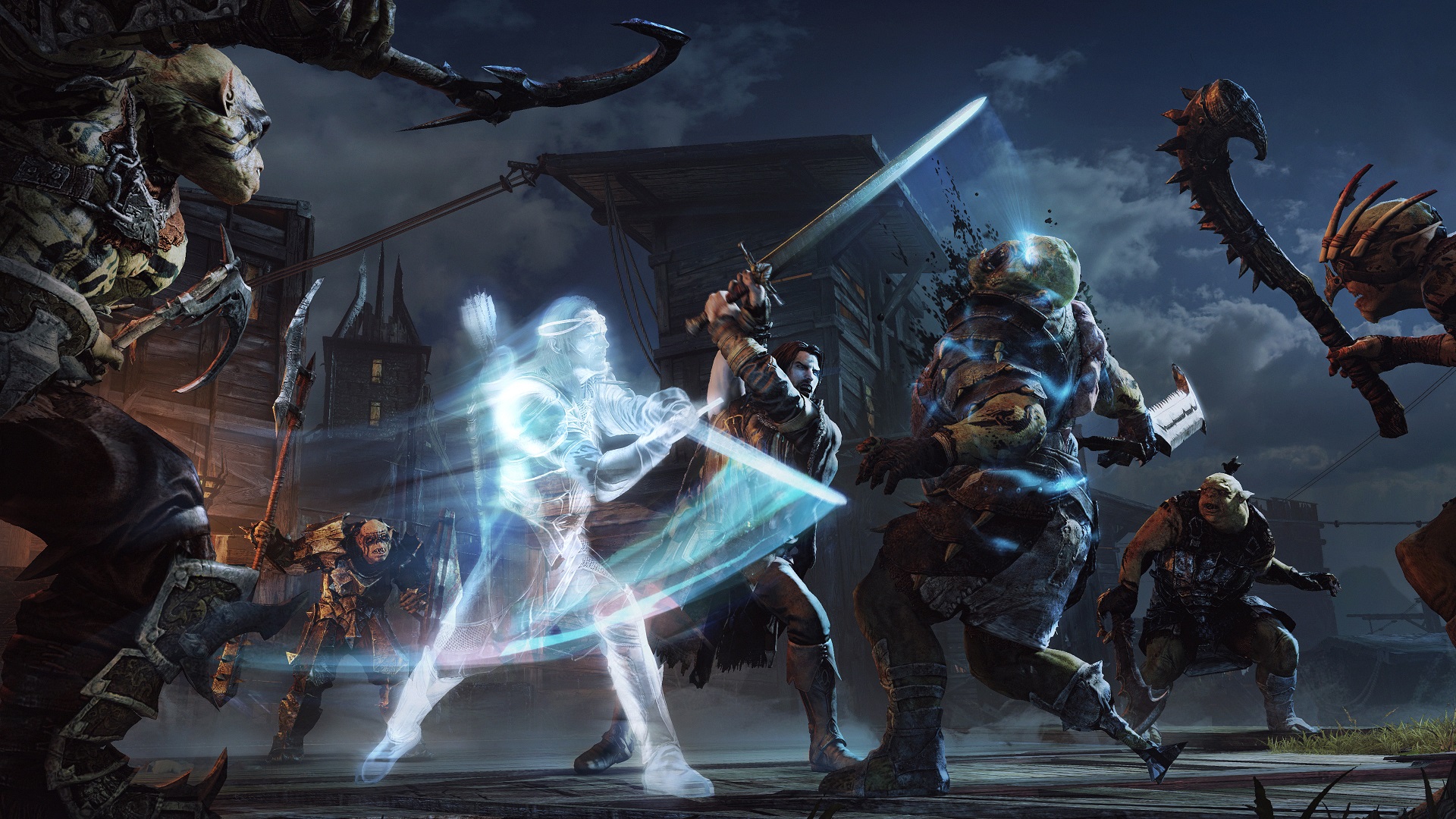
In the Land of Mordor…
For two and a half millennia, the Rangers of Gondor have stood watch at the Black Gate that separates their lands from the haunted realm of Mordor, the site of Dark Lord Sauron’s eventual resurrection. Sometime prior to the events of The Lord of the Rings, the Rangers have grown complacent in the duties and it costs them one dark, stormy night as a horde of Orcs known as Uruks invade. The Black Gate is lost and Talion, one of the Rangers, is executed along with his wife and son in a sacrificial ritual. Talion awakens in another world where he meets a nameless wraith who informs him of his untimely fate. Instead of being allowed to venture into the unknown alongside his family, Talion is instead “banished from death” and has become bound to the wraith, cursing him to walk Middle Earth forever. With Sauron’s power growing and the fate of the world in the balance, Talion and the wraith set out to stop stop the Uruk forces and break the curse, allowing him to reunite with his family in death.
Talion’s journey to take revenge upon the forces of darkness and rid himself of his curse wants to be a great experience. Thanks to the inclusion of the wraith (for whom will not be named due to spoilers), the game becomes an interesting buddy cop title with Talion the less-than-levelheaded swordsman teamed up with the wise, forward-thinking wraith. The dynamic between the two characters is one of caution, tempered trust and determination as the two must join forces to achieve each of their own ends. The characters themselves are well written, well-acted and are worthy of your attention. If anything, they are the best part of the game’s story.
That being said, the narrative of Middle Earth: Shadow of Mordor suffers from several distinct problems. The first of these (and easily the most notable) is pacing. Talion’s tale is one fraught with a mix of slow and fast pacing with nary a moment to be found in-between within the confines of the main storyline. One minute you’re discovering clues to your companion’s background, the next you’re taking on the mid-game boss with little to no pomp or circumstance leading up to the fight. Events in the game simply happen at times without prior warning or build up. The game takes on a two act structure and ends well before it should and does not conclude with any significant resolution at all. This production could have benefited greatly from having a third act but this is for naught.
Pacing is one issue but that can be tolerated but having underdeveloped characters is something that shouldn’t happen in a good story and it is here that Shadow of Mordor has another misstep. Inside of the twenty mission story, our hero encounters new characters whose arcs are either short lived or significantly underdeveloped, making you wonder just exactly how much they contributed to the overall plot and whether they were even worth including along for the ride. Extending the length of the supporting casts’ roles in the game or even simply having them all come together to play a significant part in the final moments of the story would have been a much better plan but sadly this never happens.
Apart from just the length of the characters’ stories, the game is hurt by just how much it panders to the player. At many turns, the game recycles plot elements or purposefully mentions or introduces some character that is significant to the events of The Lord of the Rings without really establishing why they really matter to the overall storyline, instead serving as gameplay vessels by which to further the plot along. Nowhere is the more evident than in the game’s inclusion of Gollum early on. Gollum only serves to give the wraith character more significance than is initially presented and appears only for a couple of missions before outright disappearing until the endgame sequence. This feels very shoehorned in and unnecessary to the continued development of the story and is, in this reviewer’s opinion, only there because the developer wanted to lend credence to the plot.
Aside from these issues, Shadow of Mordor just isn’t a well told story. While our wraith companion is fleshed out, Talion really isn’t and you are forced to visit the game’s appendices to learn more about the man he is, as is the case for many of the games characters and subplots. The game concludes with a lackluster final battle the nature of which mirrors many of the less than stellar compromises many notorious games over the years have concluded on. On top of that, Shadow of Mordor sequel-mongers like it is nobody’s business, all but outright demanding that a second game be created so that Talion’s story can receive a proper conclusion. I sternly believe that Monolith is capable of building a compelling story but, at least for me, this one’s a little half-baked.
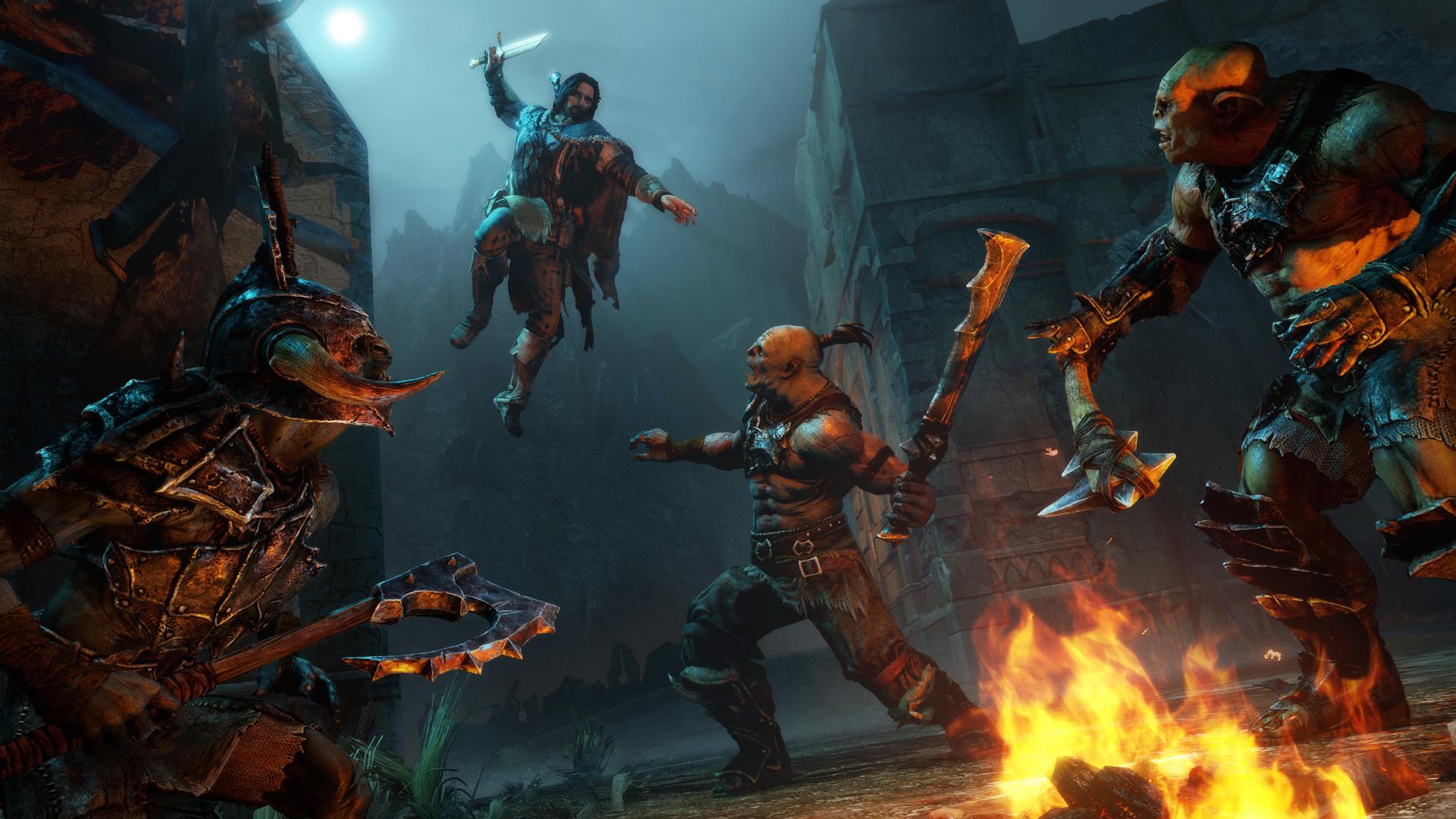
A Sidenote Consideration
Now, let’s be clear: the lore of The Hobbit and The Lord of the Rings by masterful author J.R.R. Tolkien is celebrated by millions upon millions in all forms of entertainment, be it in book, movie or video game form. It is also an exceptionally complicated beast to tackle as each book in the source material is loaded to the brim with mentions of conflicts, characters and events set throughout thousands of years of lore. Heck, even Tolkien’s words said in interviews are taken as pure fact with an example of his claiming that our world exists in parity with Middle Earth and that we seem to be living in near the end of the 6th Age. With all that said, it’s difficult to place how in-step Shadow of Mordor is with the rest of the continuity. What’s curious is just how much Monolith Productions is trying to take a step back from that despite trying to be 1:1 in its visual, audio and design preparations, in coordination with Peter Jackson, Weta Workshop and Middle-earth Enterprises. It is here that I have formed a hypothesis by which I could be 100% wrong and yelled at for. Hear me out.
This begins to become clear once you take a look at the game’s full title and take in the meaning behind it; Middle Earth: Shadow of Mordor. In all its marketing attempts and brand deals with streamers and YouTubers, Warner Bros. has been very specific to establish this game far apart from The Hobbit and The Lord of the Rings. It’s not The Hobbit: Shadow of Mordor or The Lord of the Rings: Shadow of Mordor. It’s simply Middle Earth, meaning that it is set within the full continuity of the core franchise while, at the same time, having its own focus.
But why do that? Well, to me, this seems like a blatant attempt to establish a third brand. By abandoning The Hobbit and The Lord of the Rings monikers and instead using Middle Earth, Monolith and Warner Bros. are afforded legal and story headroom by which they can create the game they want to make with whatever respect they wish to make to the two aforementioned properties inside of their own continuity. This allows them to include the likes of Gollum and others within the confines of this new storyline without compromising the overall narrative of the Legendarium. In other words, think of it this way: this is Monolith and Warner Bros. attempt to do exactly what LucasArts attempted to do with their ill-fated creation that was Star Wars: The Force Unleashed. By introducing Talion and the events set in-between the two sets of novels/movies, Shadow of Mordor allows itself to mess with the core timeline of the Legendarium without facing any repercussions on the part of Tolkien’s estate, New Line Cinema or the fans of the series as a whole. It’s a bold maneuver in my opinion and, if I am indeed correct in this regard, one that I look forward to seeing evolve over the years to come.
What does that mean for fans though? You can expect new interpretations of the events of pretty much any material that Tolkien published as well as whatever the writers at Monolith can think up. Perhaps an exiled Gondor noble by the name of Aragorn decides to take a jaunt through Mordor? Maybe Gandalf the Grey’s eagles become the basis for a new fast travel system in a sequel? Who knows? What it could mean is that series fans will have the opportunity to explore new, interesting material for the first time since Tolkien’s son published some of his unfinished works in 1980. This may, potentially, be the start of a whole new canon for the franchise… or it could all just end up fan fiction if the Tolkien estate or someone else decides to pull a Disney.
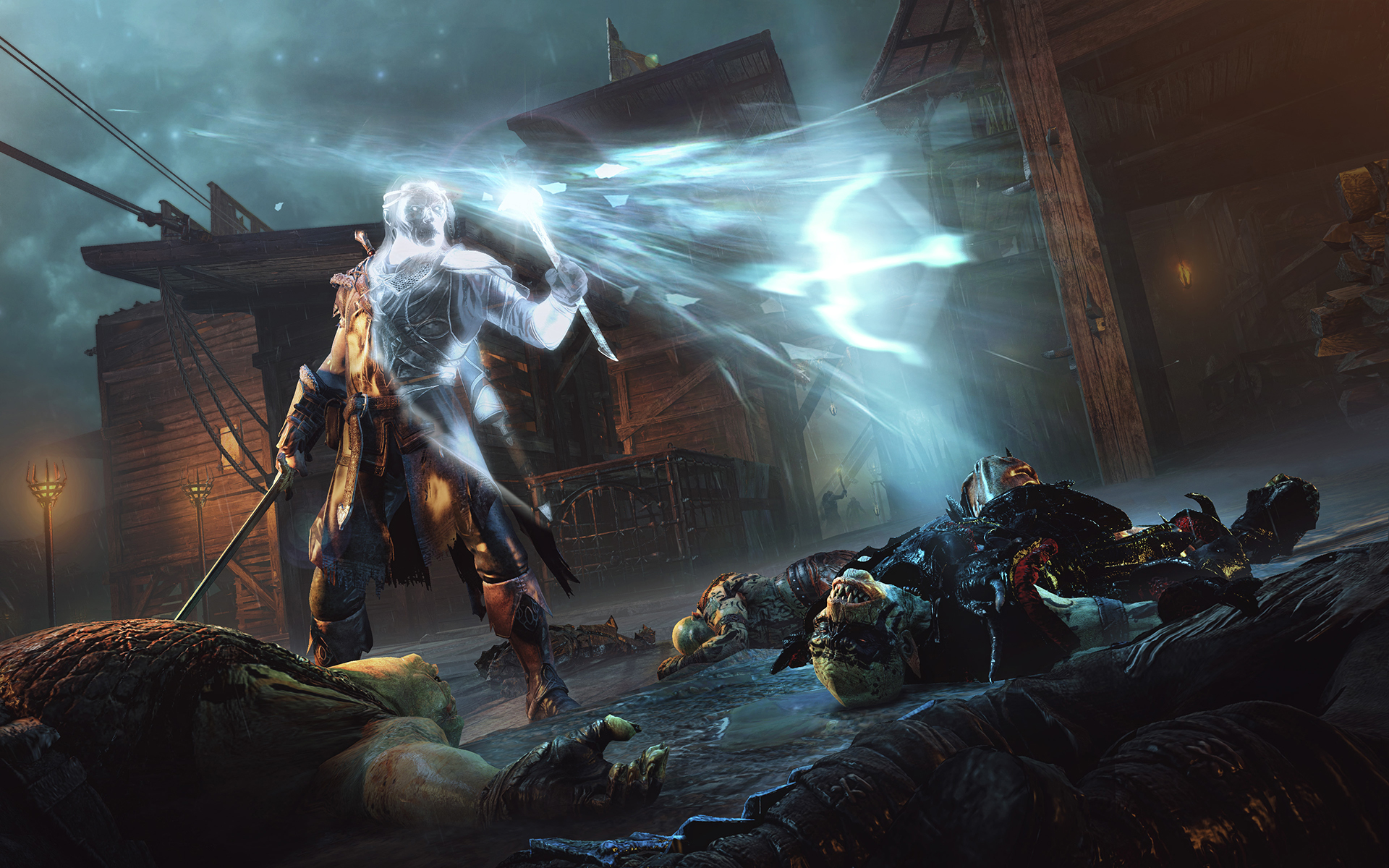
Where the Shadows Lie
From a narrative viewpoint, Middle Earth has some substantial problems that will hopefully be addressed. From a gameplay standpoint, however, the production contains some rather enticing design elements. Though there are some significant flaws to be found, the gameplay department is where Middle Earth finds its stride.
As has been the case for smart developers wanting to create a strong combat system, Shadow of Mordor borrows heavily from the brawler system created by Rocksteady Studios for the Batman: Arkham series. As Talion, players will face off against anywhere between one to a couple dozen Uruk enemies that plague the land at any given time. Players use their sword to engage the enemy and earn combos through timed strikes and careful dodges, the latter of which are telegraph to the player by way of a button prompt. As your combo meter grows, the player is allowed the opportunity to execute finishers that instantly kill normal enemies as well as other abilities such as area of effect stuns. The tools and powers that players can unlock for Talion further enhances the combat and, in the latter third of the game, results in a complicated but very engaging system that makes most encounters a breeze. There is almost nothing to complain about here and should be regarded as the high point of Shadow of Mordor.
The world design featured here and its traversal once again derives itself from an already established franchise, this time coming from the Assassin’s Creed series. Across the two distinctly different semi-large areas contained within, Talion has the ability to travel and maneuver using something very similar to Ubisoft’s parkour system initially introduced in 2007. Players will travel up, down, on top of and around steep cliffs, hills, caves, ruins, slave camps and Uruk strongholds as they seek vengeance against the enemy. Though the controller button arrangement is more Arkham than Assassin, the controls present do the job in making it rather easy to negotiate almost all environments presented.
Monolith also chose to include a stealth system derived from the aforementioned series that does well to compliment both the combat and open world structure of the game. Players can enter a stealth state by pulling and holding the right trigger, causing Talion to crouch down and conceal himself significantly more. Players can take cover from behind corners and within foliage and attract enemies to them for easy one-hit kills. The system is also fairly forgiving as Uruks have a very limited field of vision and take several seconds to react to seeing the player, allowing you precious time to correct your mistake and take down the enemy. Fans of either series will easily adapt to this new system and those who are not will only need minutes to really grasp the mechanics.
Thanks to the curse that binds Talion to his wraith companion, our hero is endowed with supernatural powers by which he can press the advantage against Sauron’s forces. The player will progressively earn many of their skills through gated story missions that greatly increase their power both from a stealth and combat perspective. One fantastically satisfying ability called Shadow Strike allows you to target an enemy from a distance and warp to their location in an instant similar to a Vanguard in the Mass Effect series, allowing you to potentially deliver a killing blow to it depending on how much you upgrade that ability.
At the heart of Talion’s wraith arsenal of powers though is the much publicized Branding ability, a key power that plays a pivotal role in the game’s story. Players eventually earn the ability to brand an enemy, Orc or otherwise, and convert them to your side. This mechanic, while taking more time than it would to deliver a typical death blow upon them, is tremendously satisfying and can be of great strategic help if you find yourself up against a boss or trapped in a particularly hairy situation.
Talions core powers are, as mentioned before, gated behind critical story missions but within his power resume you’ll find an assortment of skills and upgrades to froth over. Skill points earned through experience can be spent on active abilities for both combat and world traversal which greatly enhance Talion’s tactical potential. Passive abilities are applied directly to your arsenal of a sword, dagger and bow through runes that are dropped by minibosses found throughout the game (more on those in a moment). Players can also earn a currency-esque points known as Mirian by completing side missions and bonus objectives. Mirian, in turn, can be spent on unlocking rune slots on your weapons as well as enhancing your wraith abilities with additional health, elf arrow slots and lengthening your time-distortion Focus power. All told, the player can spend hours upon hours completing tasks and earning experience and Mirian through combat to max out Talion’s potential it is very well designed.
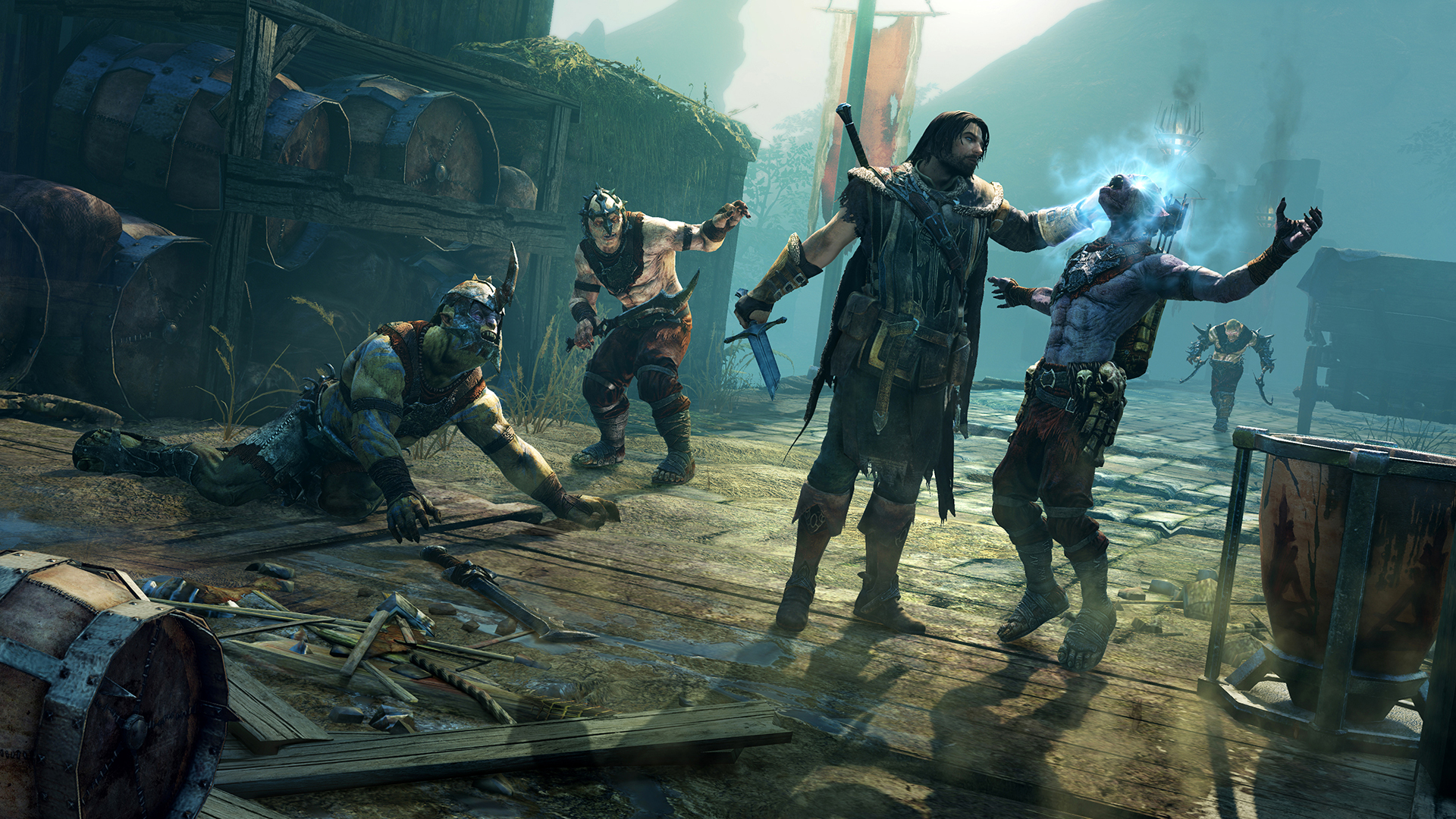
No STARS in the Moon-Lit Sky
At the heart of the Shadow of Mordor experience is the Nemesis System, a detailed attempt at providing a command structure to provide depth to both Sauron’s army as well as Orc society. At the top of the pyramid lie the warchiefs, the commanders and most powerful Orcs to be found in the land. Descending the ranks, you will find a series of decreasingly powerful Orcs who are given the rank of captain. All of the captains will vie for power by completing various actions that occur randomly over time as you continue on in the game, including but not limited to follower recruitment, duels with other captains, trials of ordeal and feasts to celebrate their prestige. All of these events will appear dynamically with each respawn and can be interacted or invaded with to a degree of success or failure depending on the player’s skill.
Captains retain significant skills and abilities that separate them from typical members of Orc society. Each will feature a randomized assortment of strengths and weakness the players must be wary or take advantage of respectfully if they wish to kill or manipulate their rank in the chain of command. Success will result in them either fleeing and stunting their rise through the ranks or even outright eliminating them from pool of contenders. Killed enemies will drop runes that passively enhance Talion’s ability but whose level and significance are determined by the victims’ power and status in Orc society. Low level kills will thus result in less powerful runes while high powered enemies that fall before you will yield higher power or even epic runes that are much desired.
Succeeding in combat against an Uruk warchief or captain is a satisfying accomplishment at almost every turn but it is when you utilize branding upon them that you really begin to see the potential of the Nemesis system. Trading out the rune reward for gaining an ally, you can command your newly acquired ranked minion to perform the feats listed previous as well as have them engage in power struggles with other Orcs, raising their power and thus making them a more potent ally. These two systems, when used in conjunction with one another, are smartly done and will be one of the more common actions you’ll take in the late game.
On the flipside, failing to stop captains from achieving their goals will cause them to game power and thus make them harder to defeat. Death at their hands will increase their power, making them more difficult to defeat in the future and potentially promoting them. Dying at the hands of a standard enemy, which happens to even the best of players, will actually cause that enemy to rise to the status of a captain if a slot so happens to be available, making them a new target of yours.
The dynamics of the Nemesis system are thus widely varied and well thought out, making it a highlight of the Shadow of Mordor experience. With a few small caveats, Monolith has something to be proud of here. That being said, Middle Earth does contain a litany of questionable design choices and overlooked items that will need to be addressed when the game receives its inevitable sequel.
For me, the gameplay structure of earning abilities is a big problem. As stated before, the most significant powers are gated behind story mission and cannot be earned beforehand. This would not normally be a problem for me had Monolith decided to allow the player more time to use Talion’s full arsenal from a much earlier point in the game but as the current product stands, you only have access to all of the abilities once you’ve completed three quarters of the core storyline itself. Branding, the most marketed ability featured in the game that paradigm shifts the combat and Nemesis systems, only comes into play over two thirds of the way through the story missions, which is very disappointing. The developer would have been much better off had players been given at least branding several missions beforehand, preferably just after you move on to the second and final area of the game.
Many would try to argue that this has been done to strong success beforehand and the most prominent example that would be thrown around is, once again, the Batman: Arkham formula. However, this argument is invalidated once you compare the nature of the unlocks in both games and their overall role in each game’s methodology. The Arkham titles, thanks to the unlocks, serve as tools by which to facilitate a Metroidvania-style open world structure, allowing them to serve a purpose outside of combat and the game’s central storyline missions through elements such as Riddler trophies. By contrast, Shadow of Mordor’s gated abilities serve little to no purpose outside of combat and don’t pertain to any unlocks or side activities. Therefore, the current structure for gating these abilities so late into the game serves only to be a detriment to the player and diminishes the overall replay value. Unless you really, really like the combat and Nemesis systems, you shouldn’t expect to continue playing all that much once the credits roll.
Combat in the last third of the game doesn’t seem to attend to the branding system either and it is here that I found myself becoming more than a little annoyed. Since players have the ability to kill any of the branded Uruk companions at any time, the combat system doesn’t seem to make distinction between who is branded and who is not. Therefore, in many skirmishes in which I have large numbers of both regular and converted Orcs engaged in combat alongside me, the combat system will not target enemy Orcs over branded ones, instead allowing me to strike my allies when I’m really trying to attack my enemies. It can be incredibly frustrating to end up killing my allies instead of my foes mid-battle, especially when I am forced to content with captains or warchiefs.
Of all the open world games I’ve played over the last few years, Shadow of Mordor is easily the least rewarding for side quest content completion. Despite featuring eight different side activities to engage in, none of them reward the player with any tangible gameplay rewards such as weapon enhancements or stat buffs. Instead, all you get is an achievement or trophy, nothing more. Collecting all 32 Ithildin icons, for example, yields only a small piece of lore and nothing else, making the hours you’ve spent collecting them feel wasted. I find myself looking back fondly at what Ubisoft has been able to include in their Assassin’s Creed titles such as AC2’s The Truth and AC4’s Mayan Armor. In that franchise, the player is rewarded considerably not just with enough lore to keep wiki editors busy for weeks but also palpable gameplay rewards. Monolith dropped the ball in this regard to me.
Other smaller items eat at me as well, though none more than what I have thus far described. Orc society seems very underdeveloped and seems fixated on the tropes of them wanting to gain power, enslave humans and serve Sauron when there simply must be more than that to their entire race. There isn’t much to explore in either region. There is no new game+ feature.
Overall, as great as the combat, stealth and Nemesis systems are, the game has quite a few flaws that can drag down the experience.
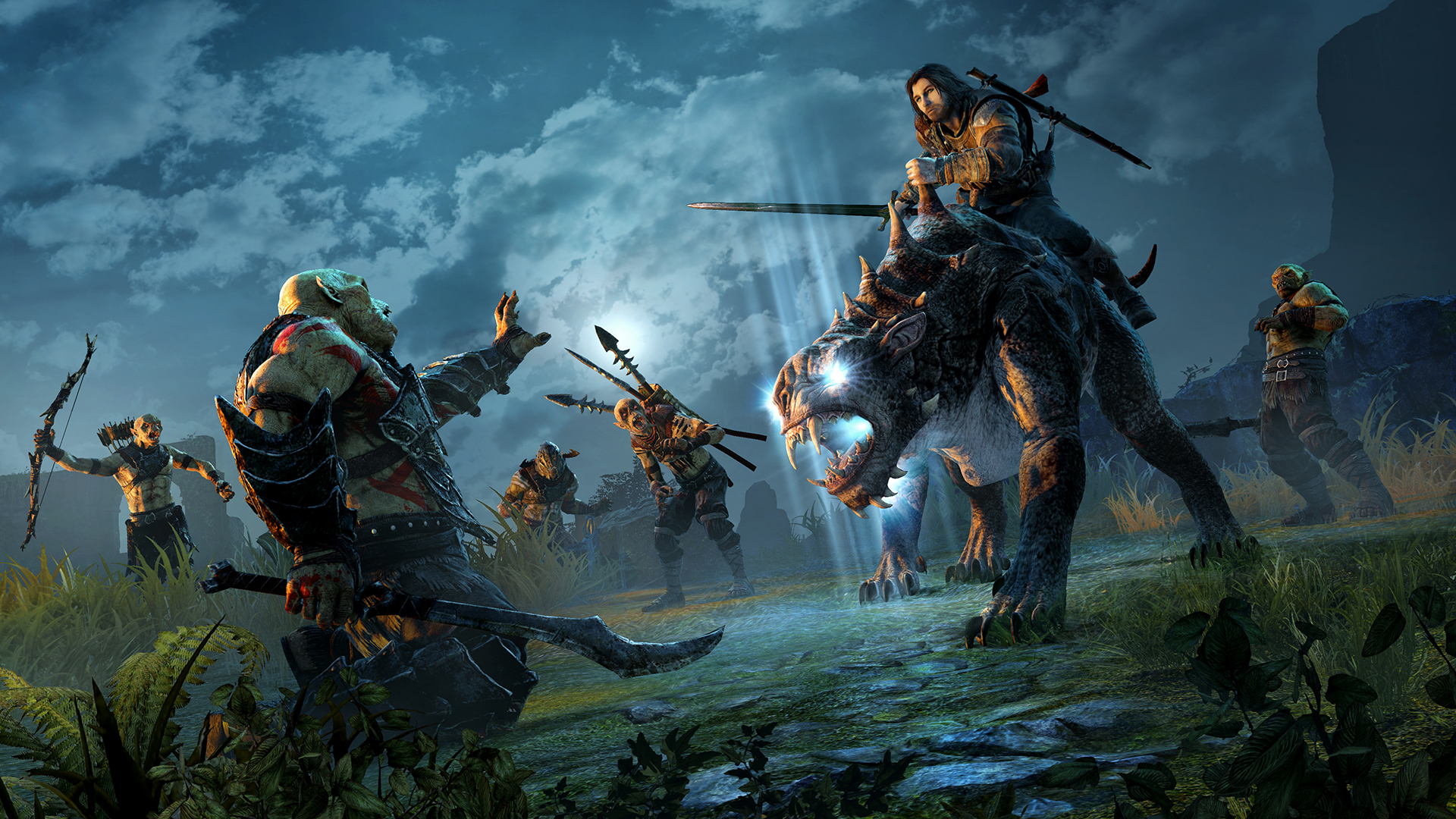
The Ascent of Gravewalker
Middle Earth: Shadow of Mordor spent four years in development behind the scenes at Monolith Productions and the effort clearly has paid off in terms of production value. The developer has done a rather fantastic job of recreating and implementing the world and character design Peter Jackson and Weta Workshop have made over the past decade and a half. No one element seems ill-designed or improperly introduced into the context of a video game and I must tip my hat to Monolith for that.
Nowhere is the depth of the production work made more apparent than when you take a look at the writing and voice work. The writing team did a phenomenal job here creating dialogue that feels embedded in the universe for the main cast, supporting characters and even random enemies. This was no doubt aided greatly by Monolith’s decision to have Christian Cantamessa, the lead writer on Red Dead Redemption, be in charge of writing the game. Though I have aforementioned qualms about Shadow of Mordor’s story progression and character usage, I never got tired of learning more about the world, the events or the characters contained within.
Monolith’s casting choices exemplify the story presentation here. Troy Baker continues his winning streak as Talion with a wide range of emotions to be found in the character’s arc. Veteran actor Alastair Duncan does a great job as Talion’s wraith companion. Even Gollum is well done as Liam O’Brien does a rather excellent job emulating Andy Serkis’ representation of the character. Not a single character, be they main cast or random NPC, feels less than properly voiced in the game and this is something Monolith can be proud of.
In terms of production, you have to hand it to the developer: they did a rather fantastic job making the most authentic Tolkien video game to date.
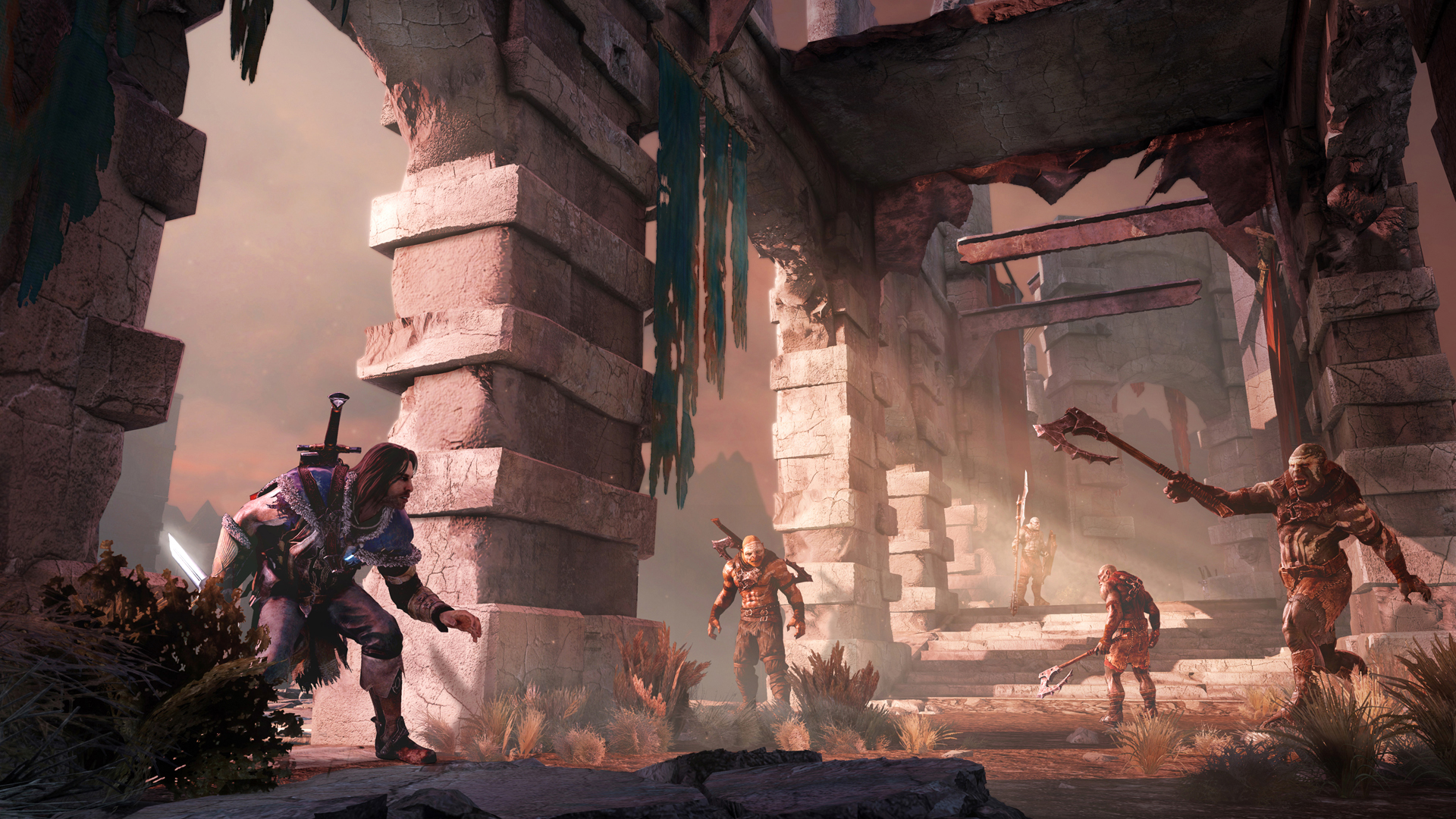
The Road Goes On
When you get right down to it, there is no denying that Middle Earth: Shadow of Mordor is a great game. Thanks to hard work on the part of a veteran developer willing to take an existing franchise in a new direction, we have been presented with the most successful reconsideration of a Tolkien product to date. The characters feel authentic. The gameplay is very well designed. The player feels exceptionally empowered. The world feels ripped straight out of the films. It’s a great Tolkien experience.
Middle Earth is a very fun game to play though it does contain within it some distinct problems, both narratively and gameplay-wise, that should be addressed once Monolith begins work on a sequel. Despite these flaws, it’s more than worth investing your time in and should definitely be on your must-play list in 2014 if you’re an action-adventure fan.
 Review,
Review,  Video Review,
Video Review,  Xbox One
Xbox One Review: Watch Dogs
 Wednesday, June 4, 2014 at 12:00PM
Wednesday, June 4, 2014 at 12:00PM
Click to read the full written review
As it has always been, when one generation of consoles transitions into another we are presented with what appear to be fresh ideas underneath of sheen of unparalleled graphical fidelity. Put into development at a time in which the old system’s potential has all but been tapped out, these titles are our first glimpses into the future of what a new console generation is capable of. More often than not however, many of these concepts that serve as transitional titles fail to meet their target in both the eyes of their makers as well as the public itself, drawing ire from all sides regardless of how the final product presents itself.
Watch Dogs is one such victim of this rather unfortunately situation. While its initial reveal at E3 2012 drew amazed looks from all around. The diligent and steadfast among us however still remember what Killzone 2 was supposed to be though. Ubisoft’s darling new IP has been the subject of great anticipation and yet, also great trepidation in the months leading up to release. Could it really meet the expectations of a demanding gaming public that wishes to see their $400 consoles put to full use? Can this new series capture the sweeping narrative potential Assassin’s Creed has tried to garner over the past seven years? Does Watch Dogs mark the beginning of a bright future for this new generation or is it simply a last gen hack job?
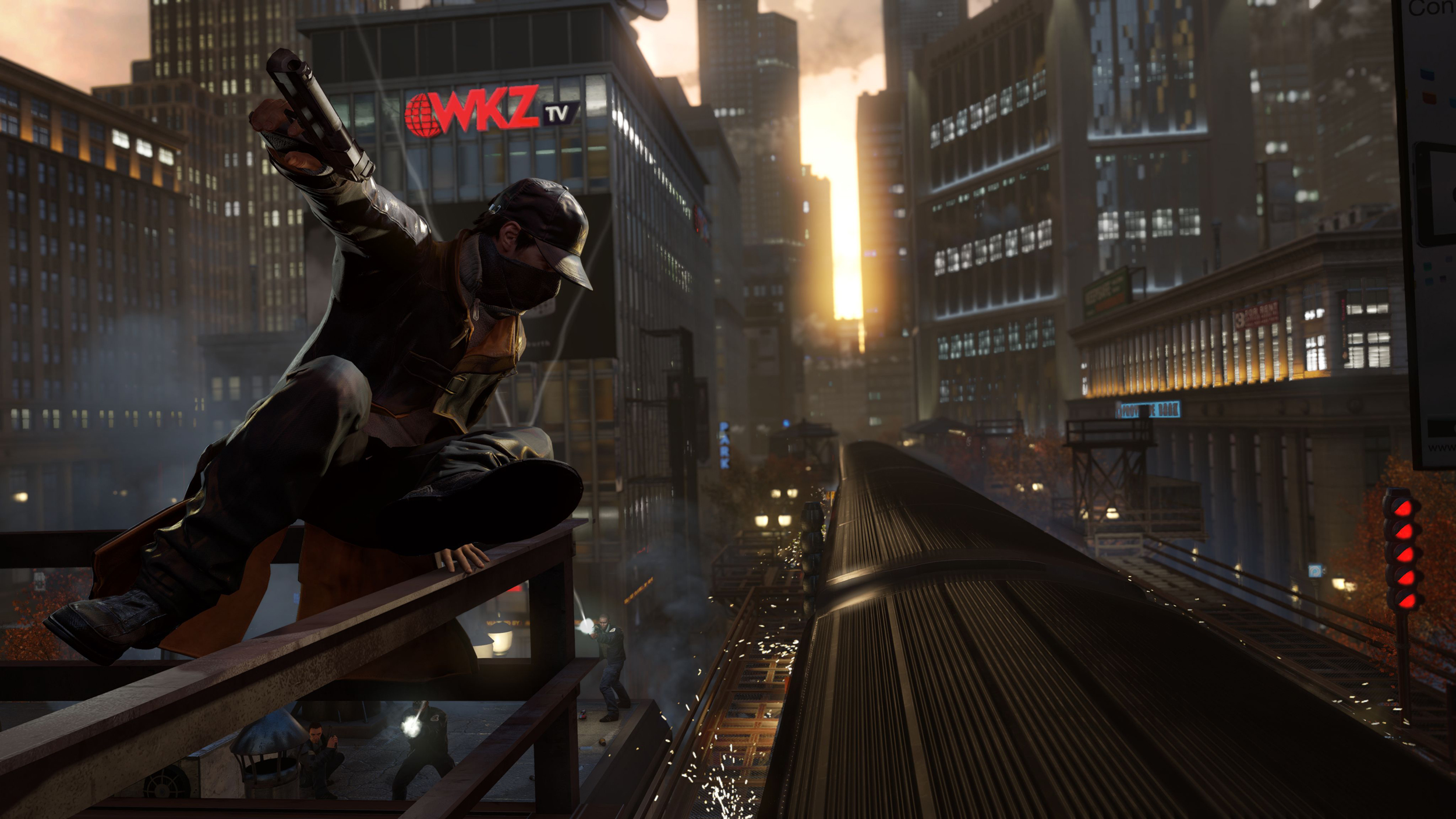 Interconnected Lives, Re-Routed
Interconnected Lives, Re-Routed
Chicago is one of the most storied cities in the United States, though the most popular bits of its history do not come from something to be proud of. The greatest of these stories hail from the 1920s in which mobsters like Al Capone ruled the streets through fear and intimidation. Despite having wished otherwise, Chicago remains one of the most dangerous cities in North America to this day. In Watch Dogs, Chicago’s government has a new weapon for a new age: the Central Operating System. A city-scale network of mainframes, the CtOS controls most of the infrastructure of Chicago, from street lights to water pumps, electricity to emergency services, all built on a vast grid of surveillance cameras placed specifically to combat crime. It’s a wet dream for the NSA but at its heart lies a dark secret: its true potential as a monitoring system that manipulates our lives and sees everything we do.
Thought impenetrable, the CtOS is a vulnerable system that has been long-since hacked. An anonymous hacker collective known as DedSec tries to warn the public of the threat the system holds for its citizens while tech-savy gangsters access its weak points to further their own ends. In the middle stand Fixers, mercenaries that can bend the CtOS to their will using advanced hacking tools at the behest of the highest bidder. Aiden Pierce, our hero, is one such Fixer.
On a typical night in 2012, Aiden and his partner, Damien, infiltrate the Merlaut Hotel on a routine money-syphoning heist. In the middle of the job another hacker appears and penetrates the same network, exposing the two. Pierce is identified by an unknown group who put out a hit on him, resulting in the death of his niece, Lena, during the ensuing attempt on his life. Grief-stricken, Aiden makes it his life’s mission to protect his remaining family and punish those responsible.
Watch Dogs has many expectations placed upon it, one of the most important being its story. After being billed as the next great IP for a new generation, much like Assassin’s Creed was supposed to be last generation, one should expect something of a sweeping narrative that challenges your perception of an aspect of everyday life. For Assassin’s Creed, it was the manipulation of history and the control of public perception built against the backdrop of a hidden war that has been waged for thousands of years. Watch Dogs should then, ideally, be about information warfare and one man’s quest to be a guardian of the people.
What we get is only halfway to this narrative goal. Aiden Pierce’s story aims to take a trip down the digital rabbit hole in a quest to get vengeance for his niece but it never really gets to that point with any flair or excitement. While the story does come full circle and resolves almost all plot elements (some are left purposefully unresolved more than likely for DLC or sequel purposes), it doesn’t particularly do so in an enjoyable manner.
The problems with the overall plot is twofold: the characters themselves and the manner in which the story is presented. Aiden Pierce’s unique character abilities (ie. the manipulation of the CtOS) as well as his plot situation has the potential to make him into a great vigilante hero but instead of fleshing him out he becomes all but one-dimensional. Occasionally he will reminisce about his actions and whether he is morally justified in committing them but once that fifteen second moment passes, we’re back on the street being chased by the police, hacking into people’s lives and taking on hordes of gangsters. Similarly, the rest of the Watch Dogs cast rarely show all that much emotion or character development to put them even in the vicinity of being memorable. Considering the background for the overall conflict present in the game, it’s reasonable to expect at least some of the characters to take a ride on a moral rollercoaster but most of the deliveries are actually quite flat.
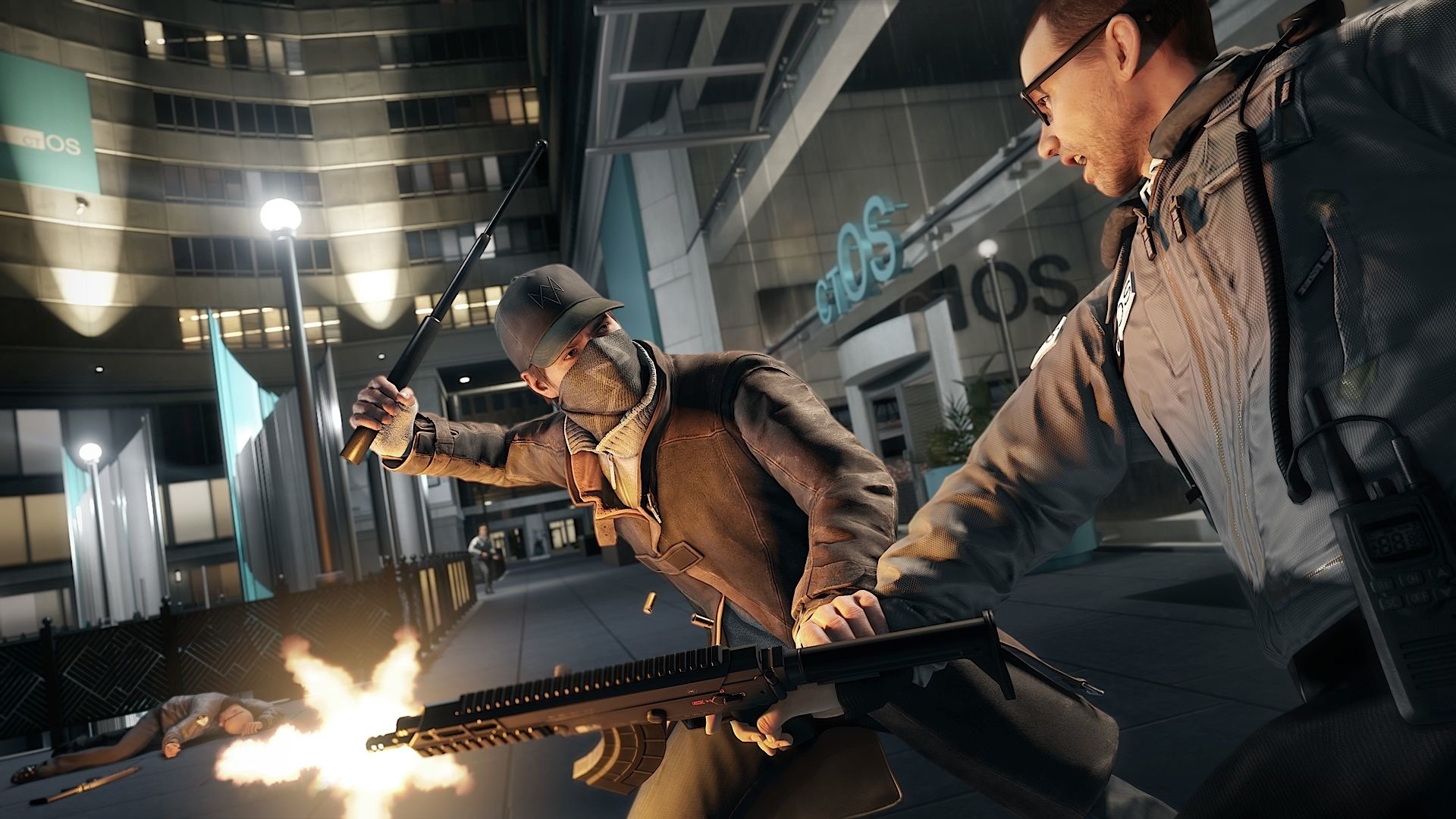 The other problem resides in just how Ubisoft chose to present the game’s story. While the game does fairly well at linking consecutive events together, that’s mainly how the story as a whole plays out. The game begins in media res, showing us a two minutes of cutscenes for the prologue before jumping forward nearly a year later without really addressing the consequences of what we just saw. It’s unreasonable to expect the audience to establish a relationship with our main character if we’re thrown smack dab in the middle of a revenge story and while I appreciate some of Aiden’s motivation, there remains a significant disconnect. In addition, Watch Dogs chooses to ignore characters once their arc has been completed, leaving some to unknown fates while at the same time never establishing more of Pierce’s personality outside of intro/outro mission cutscenes. It’s very dry, making it clear that this is a game far more motivated by gameplay than story. If Ubisoft intends to make this into a series, it would be in their best interest to rectify this.
The other problem resides in just how Ubisoft chose to present the game’s story. While the game does fairly well at linking consecutive events together, that’s mainly how the story as a whole plays out. The game begins in media res, showing us a two minutes of cutscenes for the prologue before jumping forward nearly a year later without really addressing the consequences of what we just saw. It’s unreasonable to expect the audience to establish a relationship with our main character if we’re thrown smack dab in the middle of a revenge story and while I appreciate some of Aiden’s motivation, there remains a significant disconnect. In addition, Watch Dogs chooses to ignore characters once their arc has been completed, leaving some to unknown fates while at the same time never establishing more of Pierce’s personality outside of intro/outro mission cutscenes. It’s very dry, making it clear that this is a game far more motivated by gameplay than story. If Ubisoft intends to make this into a series, it would be in their best interest to rectify this.
Analog Warfare for the Digital Age
At its heart, Watch Dogs is very much a typical sandbox crime drama game focused on a uniquely powerful character of unquestionable tactical fortitude. Players will explore a vast city environment filled to the brim with police, gangsters and everyone else caught in between. The selling twist that attempts to separate his new title from being yet another Grand Theft Auto clone is Aiden Pierce’s Fixer abilities which allow him almost unprecedented control over his digitally-powered environment.
Throughout the Watch Dogs experience, Aiden is given the ability to manipulate many of the machine run elements throughout the environment. Utilizing their access to the CtOS, players can control much of the infrastructure of Chicago such as traffic lights, bridge controls and various electrical utilities. These tools, while usable at almost any given time in the game, are best utilized contextually in terms of what’s going on around you. While sure, you can use the CtOS to terrorize the city by causing traffic jams, black outs and electrical explosions, they are far more useful when you use them against the gangs or cops that chase you throughout the Windy City’s streets.
The most common tool players will utilize during their time in Chicago is the Profiler, an app on Aiden’s phone that analyzes the NPCs in the environment and returns information about them. As a human being, it’s only natural to want to delve into a person’s innermost secrets and this itch can be scratched very easily and frequently throughout the game by simply walking down the street with the Profiler activated. At the same time, many of the NPCs in the environment have exploitable links that can be hacked into. Many of them will allow you to hack into the bank accounts that you can withdraw cash from at any ATM, listen in on a private conversation or perhaps gain new information on criminal activities. It’s a fun and simple mechanic that is all but required for many missions in the game but if you enjoyed using it as much as I have, you will not mind at all.
Outside of the core story missions that appear in the game, Watch Dogs offers a variety of side quests and standalone missions that become progressively more available as the game continues. Fixer Contracts will task you to drive a car from one side of the city to the other while completing various objectives. Gang Hideouts assign you to infiltrate a fortress and take down the head honcho, Criminal Convoys have you trying to stop a target vehicle from reaching its destination and so on and so forth. Over time, new linked quests appear that have you taking on human trafficking rings and gun runners and, for the most part, these are fun little diversions. That being said, Watch Dogs also has a huge amount of collectibles in the world that give you further insight into the game’s background characters in the form of everybody’s favorite exposition format, audio logs. Honestly, most of the collectibles aren’t worth your time and unless you’ve been diagnosed with obsessive compulsive disorder, they should be skipped.
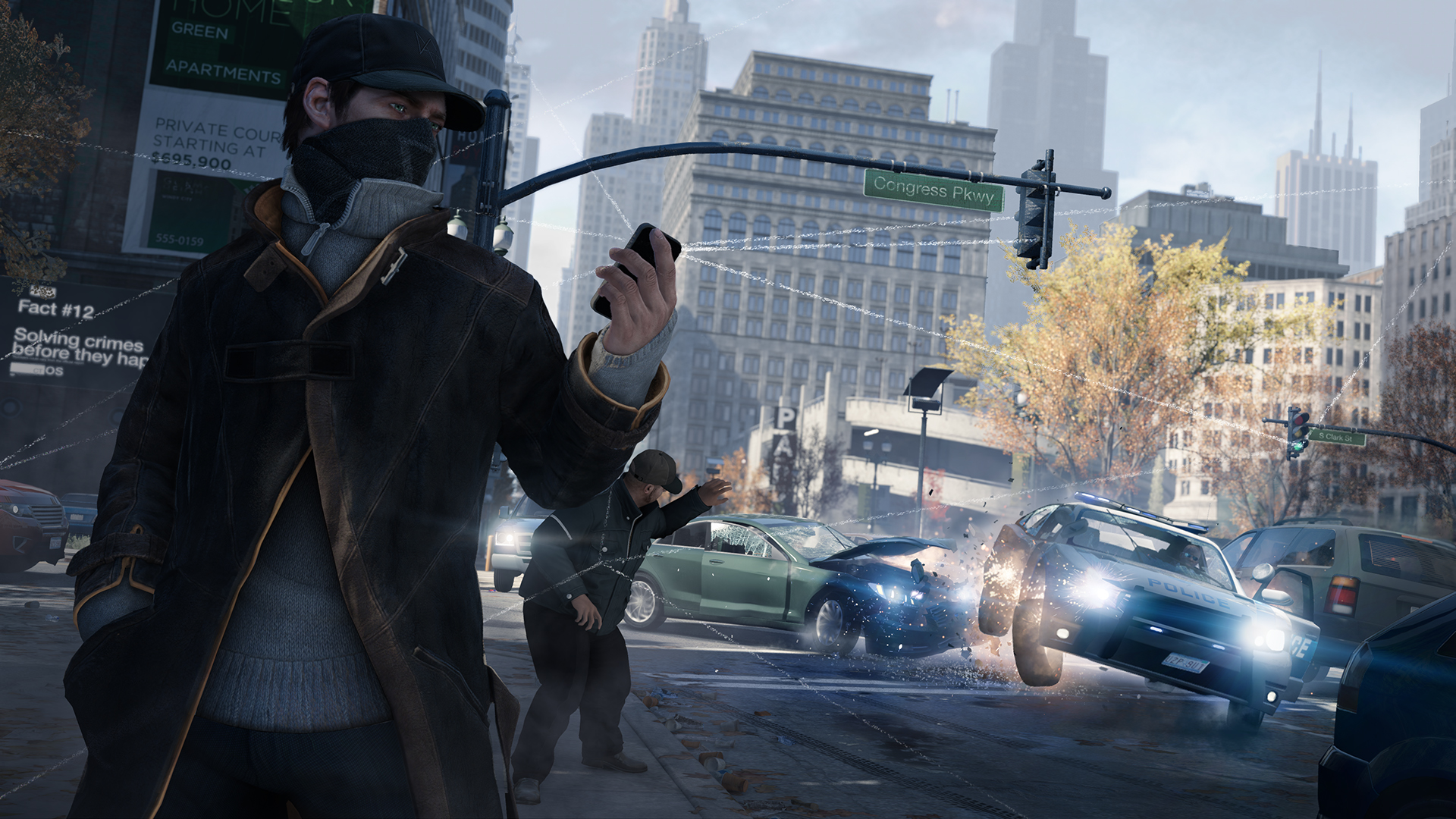
Digital Trips are easily the best side-mission highlight to be found in Watch Dogs. Much like the underutilized drugging sequences seen only a handful of times throughout Far Cry 3, these electronic-based trips serve as minigames that are a very enjoyable diversion from everything else found throughout the game. One trip has you taking the controls of a giant mechanical spider tank has you climbing buildings and wreaking havoc on the streets to rack up as much points as possible. Another features you sneaking through the dark, hiding from robots that kill you on sight while yet another has Aiden driving a Mad Max-esque armored muscle car through a Chicago hellscape running over demons and completing objective on a time limit. Everything to be had here is quite fun and should definitely be one of the first things you experience during your time with the game.
One of the more anticipated aspects of the game is the random nature by which events can happen in the game, specifically how crimes can seemingly occur out of nowhere. While these events can happen without notice, the CtOS will frequently identify pending crimes that occur proximate to Aiden’s location. The player, should they choose, can visit the area and utilize the Profiler to identify the victim and his or her aggressor. Strangely though, Watch Dogs forces you to actually wait until the crime is in progress rather than prevent it from happening entirely, eventually leading even the most prepared players into a foot chase if they choose to go in for the non-lethal takedown. Unlike the rather slick presentation of such events we received in February of last year, these foot chases usually devolve into running down a sidewalk for a considerable amount of time as there are only occasional CtOS tools like junction boxes or circuit breakers that can impede the NPC’s movement. Given this and the fact that Aiden cannot outpace any NPC in the world, the result is a chase that can last several minutes that is a drag rather than exhilarating, eventually making these missions something you want to avoid.
The random crime system is only the start of a variety of design choices that are either questionable or entirely missing. Seemingly to emphasize the CtOS system, Watch Dogs does not allow the player to fire a weapon while driving a vehicle, a staple of almost every crime-based sandbox title on the market. In addition, oddities begin to appear when you take a look at how the game’s background elements work. Bus stops are littered throughout Chicago with people waiting patiently for their ride to arrive and yet there is not a single bus to be found in the game. Motorcycles can be quite easily found in the environment and yet none of the NPCs in the game (other than in one of the opening cutscenes) ever actually drive one. In addition, the game does not feature a proper melee combat system save for a one-press takedown maneuver, instead forcing you to rely on your weaponry and the CtOS during a firefight. These and several more confusing or omitted design choices appear throughout the game and while they don’t necessarily detract from the overall experience, it certainly doesn’t add to it.
Watch Dogs certainly wants to keep you entertained with its content but it doesn’t seem competent in allowing the player to experience things as you want to. In addition to hundreds of collectibles and things to find, the game insists on informing you about things that are happening throughout Chicago whether you like it or not. Rarely will the game give you five minutes of peace without informing you about a new crime that is about to occur, new contracts that are available for the taking or news bulletins that either tell you about long outdated events that you were involved in or Aiden’s current status in the eyes of the public. Sometimes I just want to explore the city, Ubisoft, give me a break.
As seems to be the growing trend for crime-based sandbox titles these days, Watch Dogs incorporates several different RPG elements such as a morality system in order to flesh out the main character beyond his bland story background. Known as the Vigilante, Aiden has the ability to alter public perception of him based on his good or evil actions. Rescuing civilians from crimes such as what I described above will earn you good karma while tear-assing down the streets and gunning down citizens will cause this to drop into the negatives quite fast. Despite the possibilities that could come from having access to the CtOS and the constant reminders of public opinion polls regarding your status in Chicago, it’s disappointing to report that the only effect the morality system has is on how frequently the police will be called on you.
A morality system isn’t the only RPG element that Watch Dogs includes however. Skill trees gate access to hacking upgrades and various parts of the CtOS infrastructure while other trees can enhance Aiden’s combat, driving and crafting abilities. Players can also craft one-off tools that aid Aiden as you see fit. Having trouble sneaking past a bunch of guards? Cause a blackout to the area and sneak past them while in the dark. Is the enemy calling for reinforcements after spotting you? Use a communications jammer to prevent the call from going through. These tools can be crafted on the fly from the game’s weapon wheel using components and chemicals found throughout the environment and they are exceptionally useful.
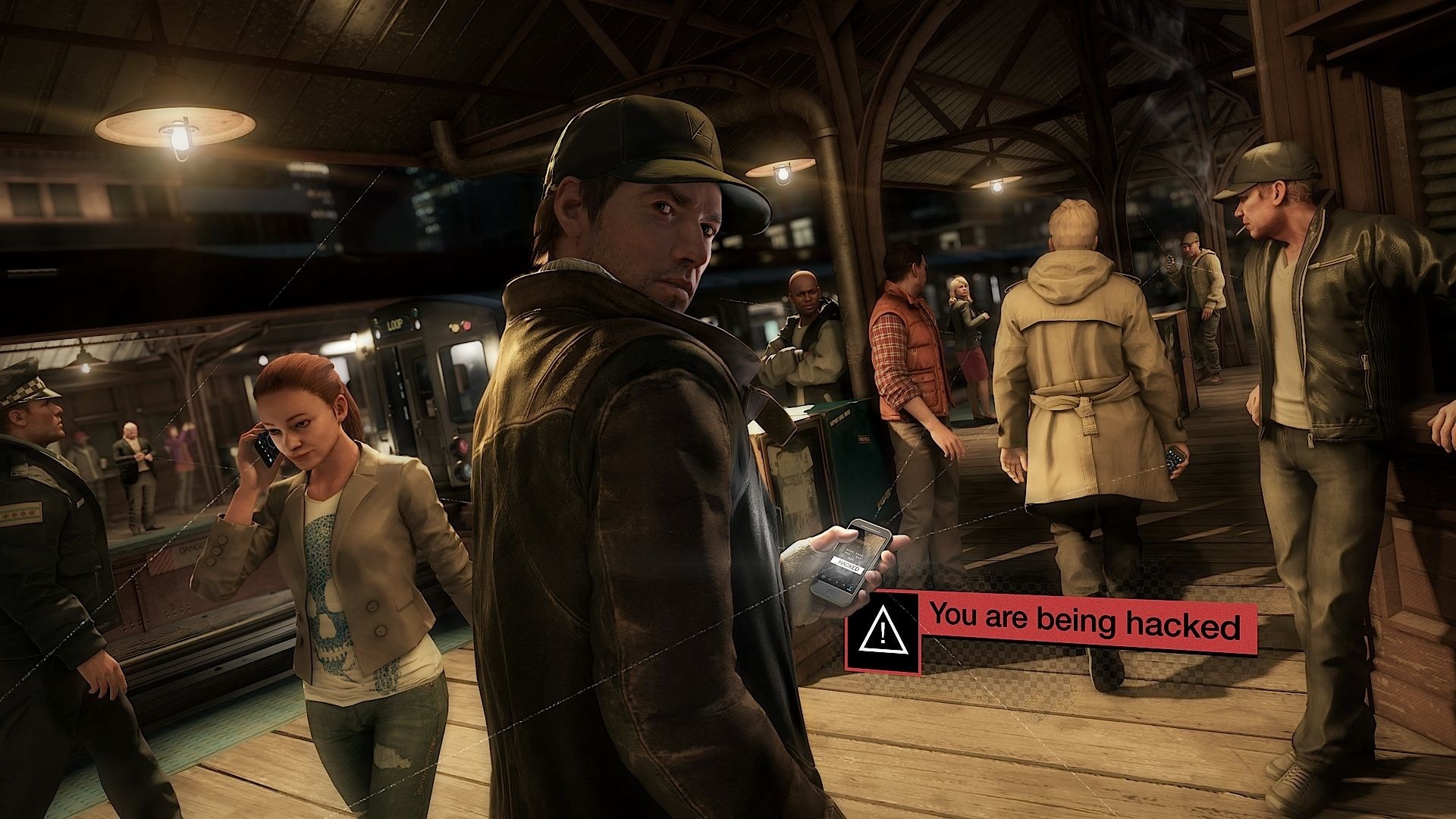
Apart from Watch Dogs’ core gameplay, Ubisoft has included online multiplayer that, in many instances, takes inspiration from Japanese developer From Software’s famous Souls series. While the game does feature the standard allotment of sandbox multiplayer modes such as free roam, racing and objective-based team combat, the invasion mechanic from the Souls series makes an appearance to a delightful degree. In Online Hacking, one player invades another’s world, appearing always as an NPC to the opponent but always as Aiden to themselves. In this Turing Test mode, one player attempts to hack the other by hiding within a certain radius while the victim attempts to hunt them down using the Profiler. If the aggressor is identified, they must retreat as they are not allowed to kill the target. Online Hacking is incredible fun and, as it can happen at almost any time outside of a mission, players should always be on guard for an invading Fixer. Sadly, the launch of Watch Dogs has been a bit tumultuous as excessive wait times for invasion attempts can quite often lead to failed connections. This, coupled with it being quite hard to locate a lucrative contract, will try the player’s patience. Interested players should take note, however, that while you can turn off the invasion mechanic, the game will reset your in-game notoriety, forcing you to build it back up once you turn it back on. It becomes a decision then: play with it on and expect to engage in multiplayer or turn it off and never do so for as long as you play.
The Cyber Frontier
As one of the first confirmed next generation games presented in 2012, Watch Dogs bore the distinction of being one of the visual powerhouses that would lead us into a bright future of graphical fidelity. As has been purported since late last year, the final product only contains a portion of the visual package that was presented to the public at E3 2012. Aside the visual effects, everything from texture models to environmental detail, animations to in-game physics are nowhere near the quality that we saw two years ago. While the package we have is still visually entertaining, the results are still disappointing by comparison.
One thing the game really has going for it is world depth though. Exploring Chicago, the city seems far more alive than Grand Theft Auto or many of its counterparts have ever done before. While not specifically a simulation experience nor having large numbers of NPCs on screen at any given time, almost every area in the game seems fleshed out and thoughtfully made. While not on the same level of authenticity that LA Noire presented, Watch Dogs seems to have done a very nice job on recreating a gameified version of Chicago so I must tip them my hat for doing so.
Watch Dogs doesn’t just seem like a visual downgrade because of these elements though as it is riddled with bugs and inconsistencies. Cutscene facial animations are par for the course but their appearance in-game is simply mouths moving opening and closing, nothing more. Some cars feature real-time world reflections on their windows but many buildings reflect a static, non-existent road and none of the character, car or background models actually present. Visual pop-in of spawning objects in the environment is very noticeable at times and can often get you killed for seemingly no reason at all. Failed transitions between two player’s worlds result in almost all objects and NPCs local to you getting despawned, only respawning when you turn the camera away from them. Some of these things may seem quite arbitrary but revealing only in the leadup to launch the actual visual content of the game is at the least being deceptive to your audience and, at most, false advertising. Activision learned their lesson about this in 2006 with the marketing for Call of Duty 2. Perhaps Ubisoft needs to take a look at what happened then and give The Division some more time in the oven.
In the audio department, what we get is once again a mixed bag. The game’s voice acting certainly has potential (a performance by Christopher Jacot is quite nicely done) but Noam Jenkins, who plays Aiden Pierce, doesn’t even come close to the presentation Brian Bloom brought to BJ Blazkowicz. Man, that’s a comparison I never thought I’d type. It doesn’t help that most of the game’s script is missing a hefty amount of raw emotion or depth. You can’t make an audience care about a character when only their words convey who they are and it seems that the core team that worked on Watch Dogs didn’t get that memo. Perhaps they should go next door and take some notes from the Assassin’s Creed team.
The rest of the audio presentation is fairly well done though. Sound effects can come across quite raw and visceral at times with traffic collisions providing a very suite of metal upon metal crunching and grating against one another. Strangely though, the audio for certain effects such as the roar of an engine can suddenly be quietened or disappear altogether for some unknown reason. Watch Dogs’ soundtrack features a mostly digital or synth presentation with occasional orchestra elements thrown into the mix. However, the soundtrack is mostly subdued and doesn’t really build any momentum except at only a few key moments throughout the game. It’s good when it really wants to be but when you find yourself roaming the streets of Chicago just for the sake of doing so, it all but abandons you.
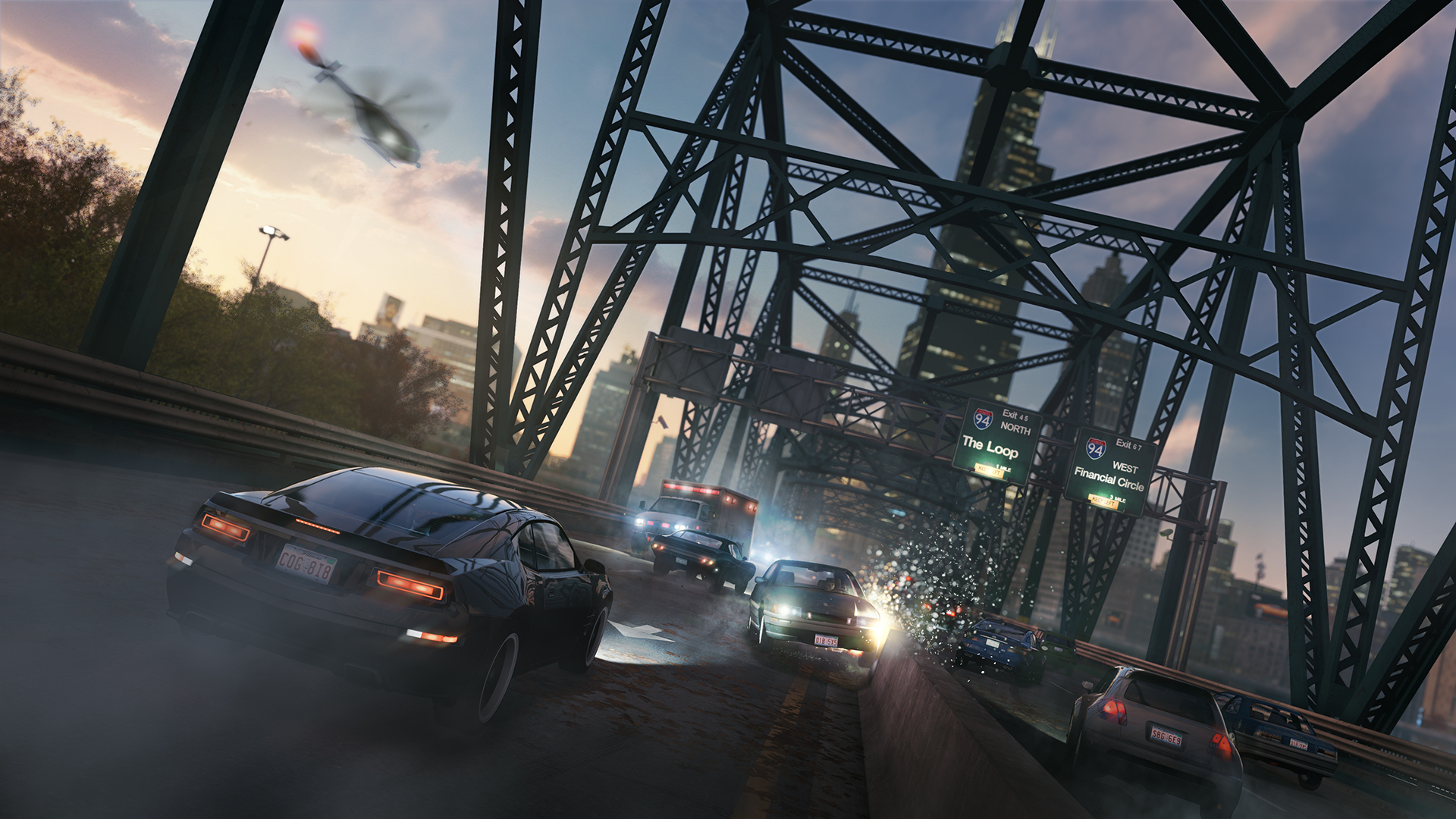 Watching the Watchers
Watching the Watchers
Watch Dogs is a game of many contradictions. It wants to be a great story experience but it’s hampered by uninteresting characters and a disappointing presentation style. It wants to be a great sandbox game but trades in staple design elements of the genre for player-controlled environment manipulation when they could all certainly live in harmony. The online multiplayer can be rather fantastic to play but only when it wants to work. The presentation is nice but is two steps down from the fidelity and presentation we got at E3 2012.
Watch Dogs as a series certainly has potential. It introduces several interesting ideas to a genre that doesn’t see all that much innovation anymore. However, it should also stand as a cautionary tale on overselling a product. It’s certainly worth experiencing if you go into it with an open mind but if you’ve been following its development over the past two years, steel yourself for being left in the dark to howl at the moon.
 Review,
Review,  Video Review,
Video Review,  Xbox One
Xbox One Review: Wolfenstein: The New Order
 Monday, May 26, 2014 at 10:00AM
Monday, May 26, 2014 at 10:00AM Click to read the full written review
One of the most common things people will complain about in the film industry is that there is no originality left in Hollywood. Though I wish I could argue otherwise, the same can often be said about video games. Too often these days we see one semi-original game come out and, in the half decade following it, publishers release a slog of conformity hoping to recreate the greatness that was that single title. In the ensuing aftermath, older ideas are tossed by the wayside, discarded as if doing otherwise would be an insult to the player’s intelligence. It’s a shameful practice but it’s also a reality we have to face daily. Such is the fate of the shoot ‘em up, the side scrolling beat ‘em up and the run-and-gun unrealistic shooter.
However, every now and then we get a throwback to that golden age when design decisions came more out of necessity than choice, when triple-A titles didn’t have to conform themselves to as common an audience as possible and when developers weren’t being pushed by publishers to make the next great cash cow of a game. These titles are excellent time capsules that remind us of an age gone by but the truly impressive ones are those that manage to bridge the gap between old and new and do so well. Wolfenstein: The New Order from freshman developer Machine Games want to be that rare blue moon of a title.
With five years having passed since the last title in the series and a triple-A industry devoted to creating the next Call of Duty, Grand Theft Auto or the League of Legends killer, does The New Order have the strength to remind our games’ publishers that victory doesn’t have to be found by copying in the present but instead looking to the past?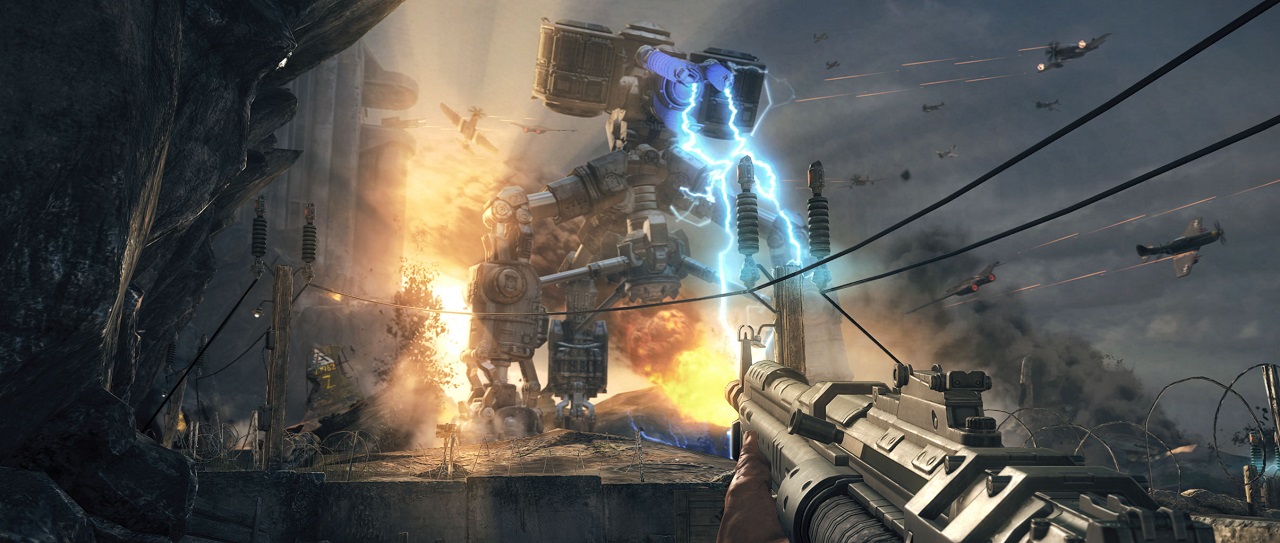
When The War Was Lost
At the break of dawn on July 16th, 1946, more than a year after our Allies defeated the fascist Nazi army, the armed forces of the free world mount a desperate attack on the fortress of General Wilhelm "Deathshead" Strasse, one of the most powerful men in the Nazi army. Where once the Allied powers pressed the advantage, the Germans have turned the tide and are driving their enemies back to the sea thanks to unprecedented advanced technologies of unknown origin. General Deathshead is believed to be the mastermind behind the Nazi’s radical new weaponry and at the spearhead of this last-ditch assault stands Captain William “BJ” Blazkowicz, the Office of Secret Actions agent responsible for defeating him twice before.
Though the allies make a valiant effort, the mission is ultimately a failure. Blazkowicz finds him blast out to sea, taking shrapnel to the head and leaving him in an almost vegetative state. Trapped in his own body, BJ watches with flickering consciousness as the world goes on around him from inside an insane asylum in Poland. What seems like minutes or days passing is, in reality, months and years and before he even knows it he finds himself finally waking up in 1960, fourteen years after his final mission. The German empire, once on the ropes, now rules the world and the people under their thumb suffer for it. Free of his comatic prison, Blazkowicz resolves to find the resistance and get back to doing the one thing he is remarkably gifted at: killing Nazis.
Any shooter fan out there with a reasonably decent head on their shoulders can tell you that the Wolfenstein series has never been known for its narrative capacities. After all, as the granddaddy of the first person shooter, its origins are derived from a time in which the most common installation methods were either by three and a half inch floppy discs or via shareware. Needless to say, when your game is meant to be a technology demonstrator with a focus on gunning down fascists, one shouldn’t exactly expect a focus on story development. Though the series received a story-focused sequel in 2001 with Return to Castle Wolfenstein which reboot the series, the only entry to arrive after that was Raven Software’s singularly-named Wolfenstein in 2009. That title suffered from a horrendously-developed multiplayer component and an extremely divisive sandbox hubworld design so, given that title’s poor sales figures, it’s reasonable to suggest that any new Wolfenstein game would ignore the previous entries and try to establish its own continuity.
The New Order is not such a game. Rather, at many instances it scoffs at the notion of ignoring what has already been established. The game, instead, readily acknowledges the events of Return to Castle Wolfenstein and its 2009 sequel. Old friends and antagonists return, once fought enemies receive a fresh coat of paint and a new suit of armor while BJ and crew actively mention key moments from both previous titles. I find it remarkable that a freshman developer would go the lengths to actively both establish continuity with an already obscurely-connected storyline while at the same time progressing it to a place that allows for a considerable amount of freedom so I must take my hat off to the folks at Machine Games.
Though this may be the first title for this developer, its aptitude for creating a story shouldn’t come as a surprise. Machine Games, opened only in 2009, was founded by key employees of Starbreeze Studios, specifically the teams responsible for The Darkness and The Chronicles of Riddick. These guys know how to make a story but, more importantly, they know how to tell one.
Wolfenstein: The New Order’s story is, admittedly, a decent one but what really makes it stand out is the format by which it is told. Though mostly a traditional first person title, the game is interspersed with a fair amount of cutscenes that do well to compliment the action without taking the player out of the moment. At several moments throughout the game the control is taken out of the player’s hands for an interactive moment, usually forcing the player to make a decision. These scenes are fantastically told and acted, making them a strong narrative highlight.
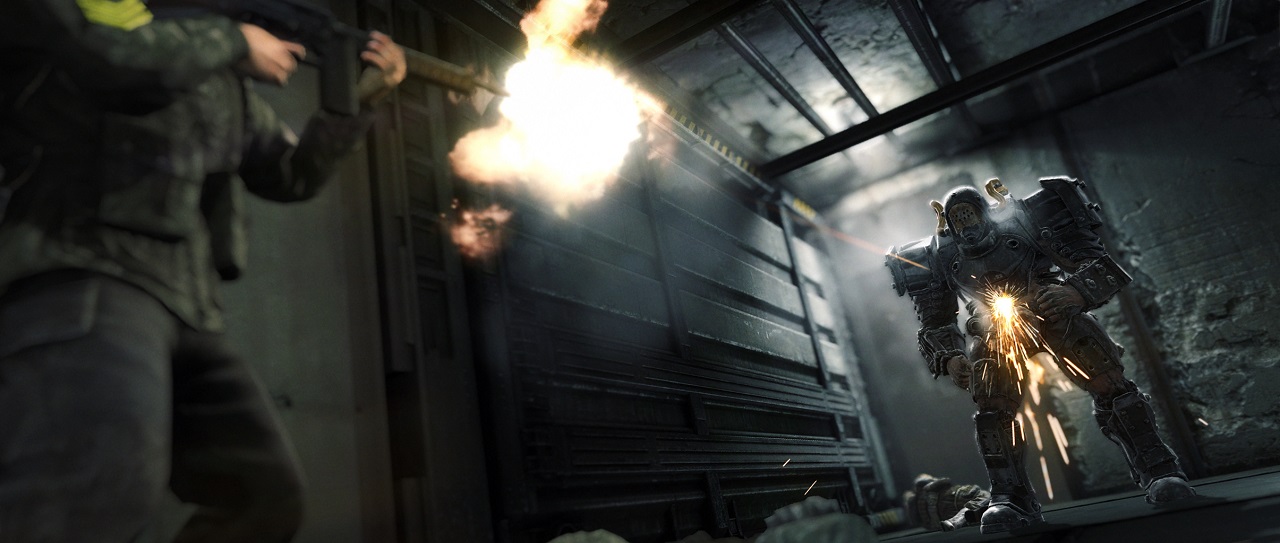
The best part of the story, however, is the narration. BJ Blazkowicz, or any id Software-originating character for that matter, have never been known for their storytelling prowess but Machine Games has channeled their pedigree and brought us narration in the same manner we got in The Chronicles of Riddick and The Darkness. The results are simply wonderful as it turns out as BJ Blazkowicz is a remarkably introspective character. As he continues on his vengeful stride against General Deathshead, his comments on the terrible crimes of the Nazi war machine while reflecting upon his own personal losses and hatred for the man are terrifically done thanks to a rather spectacular performance by a grumbly-voiced Brian Bloom. Everything from a one-liner about cursing the moon for allowing Nazis to land on it to a rather emotional recitation of Emma Lazarus’ The New Colossus are wonderfully done. Though one wouldn’t expect it, the game’s dialog easily stands shoulder to shoulder with many great recent titles such as The Last of Us, Bioshock Infinite and even Half-Life 2.
Despite featuring a few plot holes here and there as well as forcing the player to discover most of the events that occurred during BJ’s fourteen year absence, Wolfenstein: The New Order is a very well done story to experience.
Return of the Tempest-Tost
If we’re honest with ourselves, the shooter formula of the past eight year has followed a singular model: shoot bad guys from cover, duck behind cover to heal for a time, rinse and repeat. It seems that the days of the shooter being about mad dashes and precision aim with crazy weapons is gone but Wolfenstein: The New Order looks back on those days with a fond eye. Rather than ditch one formula for another however, this title instead tries to meld two to a surprising amount of success.
At its heart, much of The New Order is built around a soft cover-based combat system similar to that of Killzone in which pressing up against cover and simply pulling the left trigger allows you to aim down sight over the edge of your cover. Alternatively, players can press and hold the left bumper (L1) and contextually lean as they see fit, allowing for quite a bit of freedom in sticking to one spot. It’s a very easy to use system and I hope that developers take notice of it and try to incorporate it into their own shooter franchises.
This new Wolfenstein, however, comes from a pedigree of classic run-and-gun shooters and it readily acknowledges this fact by making such a playstyle a very acceptable option. Players have the ability to sprint, slide and blow away enemies with dual-wielded weapons such as assault rifles or even automatic shotguns because to hell with logic, it’s fun! Most encounters you will find will facilitate using both playstyles but one would imagine that today’s laser-accurate enemies would quickly turn you into a pile of human mush but this is in fact not so thanks to the games abundance of support elements.
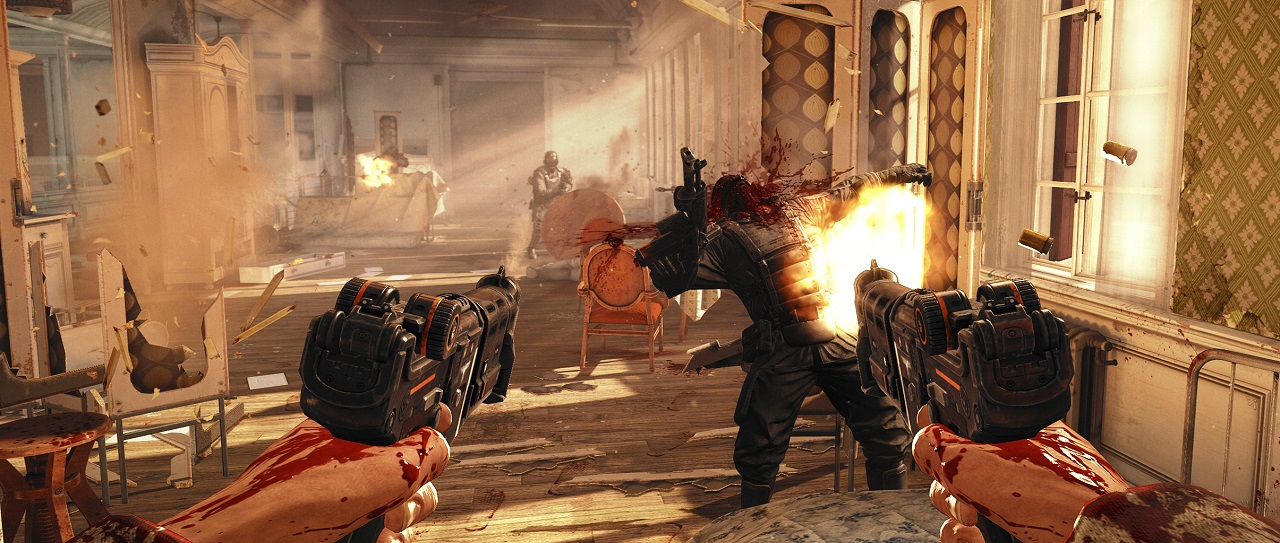
Once again taking notes from two different eras, The New Order features a rarely-used segmented regenerating health system to keep BJ in the fight. Health regenerates in bunches of twenty and can be healed further by finding health pickups such as medkits and food that are littered throughout the world. The interesting part of the health system players should take note of is that it automatically regenerates health to the next increment of twenty so, for example, if you happen to pick up five health when you are at 60, it automatically takes that and pushes you to 80. Quite easily, one can regain most or all of their health bar by simply waiting for the regen segments to complete before picking up another health item. In addition, players can overcharge their health in a similar manner to that of old school competitive shooters such as Quake, allowing you to boost it as much as you want through health items at the cost of it slowly degenerating until it returns to you max health limit. Overall it’s a very smart and easy to use system that keen players will take advantage of if they think their actions through rather than just running and picking up items all willy-nilly.
Taking another page from today’s playbook, Wolfenstein incorporates a perk skill system. Earned in the same manner as achievements are done nowadays, players can unlock these perks by doing certain actions such as getting five kills within ten seconds with a detached turret or overcharging their health to two hundred. Dying in the middle of a firefight or restarting from a checkpoint does not take away the overall count you’ve been working toward so it is quite easy to actually grind toward earning these permanent character attributes. Yes, you read that right: you’re grinding in a first person shooter.
One interesting element that Machine Games decided to incorporate is the Area Commander, a Nazi officer in charge of certain sections of maps. These officers will radio for help upon seeing you, spawning waves of reinforcements and making a previously normal combat scenario significantly harder. It is here that we are introduced to an element that has never really been a significant part of any Wolfenstein game: stealth. As with these Area Commander sections, most of the levels in The New Order feature at least several points on a map in which the player is strongly encouraged to stealth the area. Stealth can be easily accomplished thanks to the inclusion of throwing knives, silent yet violent takedowns as well as a silencer for your pistol. Stalking enemies through hallways even atop the occasional rooftop feels quite satisfying, once again channeling Machine Games’ strong past when they worked at Starbreeze. Heck, this might be the closest stealth fans may get to Dishonored 2 when/if it sees the light of day years from now. It’s a rather simplistic system, to be sure, but it works quite well and doesn’t completely discourage the player from wanting to slaughter them all with hails of bullets.
Wolfenstein’s level design once again harkens back to more classic ideas of segmented level design, bookending each level with a cinematic that is player-triggered rather than timed or scripted. The levels themselves are, for the most part, quite linear but stay true to the spirit of the classic id Software titles with a bunch of things to find and explore. Hidden passageways, alternate routes and various other secrets abound throughout the game and really encourage exploration before moving on. The levels themselves tend to be quite varied in their architecture with maps ranging from a London-based museum dedicated to Nazi space exploration, to a visually (and wisely) neutered concentration camp. No two areas ever feel alike which I found to be quite enjoyable.
Replay value is quite strong for Wolfenstein: The New Order thanks to a series of collectibles as well as an interesting branching system. Throughout each map you can find multiple different collectibles such as Enigma Codes (collecting all in a series will unlock a new gameplay mode), letters written by the inhabitants of the world, weapon upgrades and, of course, gold and jewels. The true replay value for The New Order doesn’t come from these elements. Rather, it is the aforementioned branching system known as Timelines.
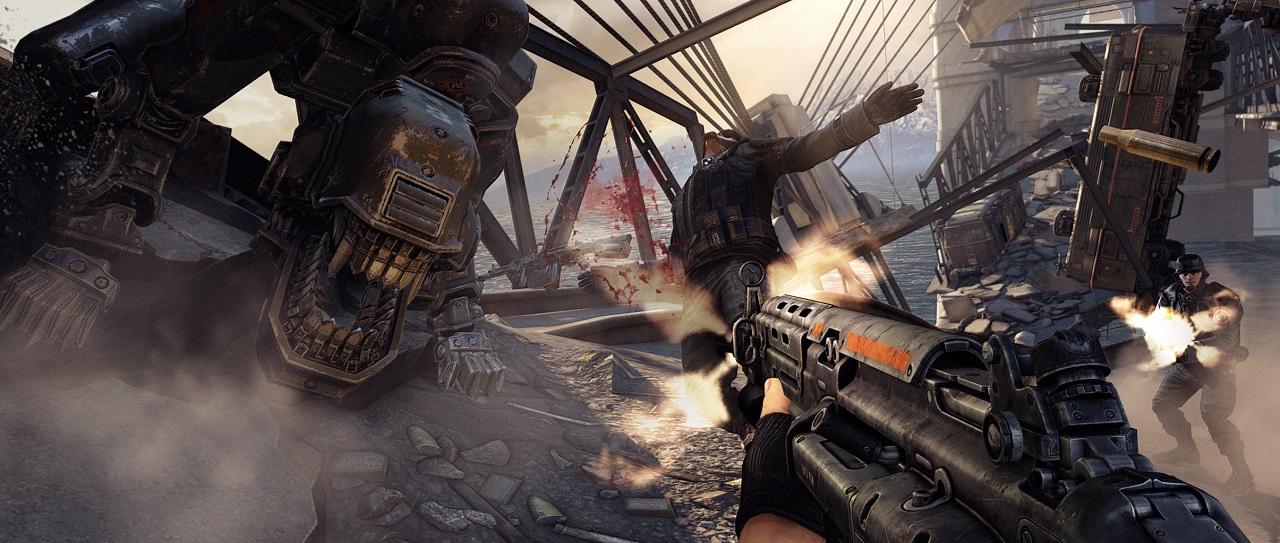
In the first mission of the game, players are forced to make a decision that results in the death of one of two characters. In turn, that shifts the game’s direction into a timeline. Though the vast majority of the game remains the same between the two timelines, small yet quite noticeable differences appear throughout the experience. You learn a different exploration skillset, certain areas of a map are in/accessible, cinematics are presented in a slightly different manner, side-story characters are replaced and levels even sometimes branch in different directions, though always toward the same inevitable outcome. It’s a really interesting way to approach replayability beyond simply adding a new mode or difficulty level to the mix and the results are appreciated. Machine Games seems intent on making your journey in the shoes of BJ Blazkowicz one that’s simply not over after a single playthrough and they make a strong argument for diving right back in after the credits roll.
Wolfenstein’s gameplay, as a whole, is a rather great experience with the only really prominent flaw being Machine Games’ world building. Outside of the central plotline, most of the backstory about characters in the world as well as how the Nazis took over the planet during BJ’s fourteen year slumber is something the player has to actively search the environment for. Even then, lots of questions remain completely unanswered. What happened to the US? Why is Hitler only mentioned once throughout the entire game? What impact do your actions really have on the world and how are other resistance cells faring? These and many other questions remain unanswered by the end of the game though we can probably expect many of them to be things the inevitable sequel should focus on.
The Teeming Shore of the New World
Let’s get this right out of the way: Wolfenstein: The New Order is simply gorgeous. Running on id Software’s proprietary idTech 5 engine, the same one that powered Rage in 2010, the results are spectacular. Unlike Rage, however, this version of the engine features almost no texture pop-in which is something I was previously worried about. Character models look fantastic with only a handful of flat, uninflated textures to be found throughout the environment, but that’s understandable. Terrain destruction is well done and will quickly force corner campers to reposition thanks to the variety of destructible cover available. The cinematics themselves are quite nice thanks to smart framing, great model animations and strong pacing as they don’t beat around the bush in informing the player of what they want/need to know in order to further the plot.
In terms of audio, Machine Games’ has an equal amount of high and low points. As previously stated, Brian Blooms narration of BJ Blazkowicz’s internal monologue is fantastically done as well as that of several of the games antagonists. On the flip side, the actual musical score of the game is strangely downplayed with the exception of a handful of the cinematics. Though the game featured some rather great marketing in the form of German versions of 1960s Americana songs as well as some original pieces, the soundtrack itself feels almost muffled by comparison and contains no real core theme for anybody except Deathshead himself. I find it weird that Mick Gordon, creator of the stellar soundtrack to last November’s Killer Instinct, was unable or not allowed to craft a core theme for BJ, let alone one that reflects his inner anger and sorrow at the events that take place around him. It’s pretty unclear just what happened here but the results are a tad disappointing.
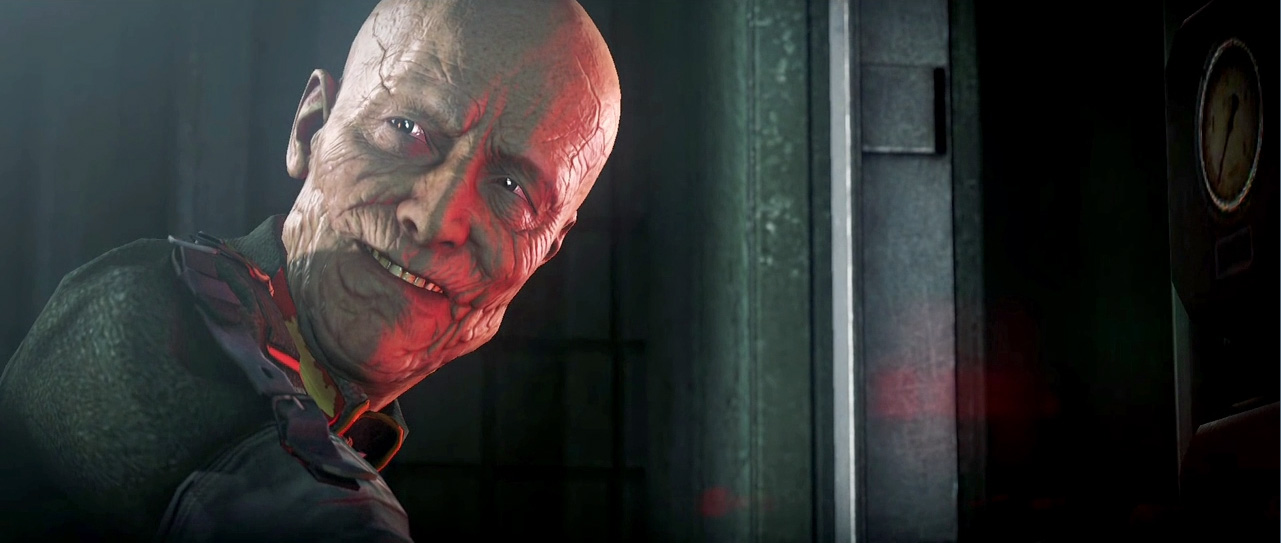
The Torch of Imprisoned Lightning
Wolfenstein: The New Order is a game I would have never expected to play three years ago. An interesting, story-based Wolfenstein game with great character development that felt just as great as its 1992 incarnation? I would have declared that an improbable suggestion. And yet, here we are. The New Order doesn’t break any ground that hasn’t been tread before but instead mixes a lot of great ideas, both old and new, to form a very well-told story. It has its flaws, to be sure, and faces some stiff competition in the coming months but it certainly seems to be the most delightful surprise of 2014. The lesson here is that you don’t have to teach an old dog new tricks: instead, you should let it teach you some old ones.
 Review,
Review,  Video Review,
Video Review,  Xbox 360
Xbox 360 


It takes a lot for an independent third party developer to set the world on fire these days and more so if your game exists within a genre that has been, quite literally, done to death. Three and a half years ago, developer Techland was able to do just that with Dead Island thanks to a trailer depicting the violent death of a little girl and her family played in reverse and set to some somber piano music. Despite being the biggest commercial success, the game was of questionable quality thanks to very repetitive gameplay and one of the most boring stories of the generation. Dead Island had potential, to be sure, but it’s clear that Techland vision for an open world zombie game needed a significant adjustment.
Now, a little over a year on since the release of a new generation of hardware and when the zombie genre is seeing some of its greatest fatigue, Techland has unleashed their spiritual successor to its 2011 success with Dying Light, retaining Dead Island’s open world and melee combat-focused themes while throwing in parkour movement and a gameplay-changing day/night cycle. With so many people complaining of zombie fatigue these days though, does Techland’s latest deserve to be in the spotlight or should it just be left to rot in the dark?
Dead By Dawn
For three months, the Turkish port city of Harran has been under military quarantine. Prior to the much-anticipated Global Athletic Games, an unknown virus has swept through the once prosperous town, turning most of the inhabitants into mindless, flesh-eating creatures. In the weeks that have followed, the Global Relief Effort has maintained a steady stream of aerial supply drops to support the remaining survivors trapped within the walls of the city. The rest of the world watches from afar as the government plans to firebomb Harran in the hopes of wiping out the infection in just a handful of days.
Enter Kyle Crane, a secret operative for the GRE. His mission: infiltrate the Harran quarantine zone, retrieve classified documents related to the virus and escape the city before the purge begins. Of course, just like you would expect: things go belly up from the moment he hits the ground. Ambushed by bandits, Crane unfortunately attracts the attention of the victims of the virus and becomes infected. Rescued by members of The Tower, one of the last remaining strongholds against the undead, Crane must secretly go about completing his objectives while aiding the survivors.
When it comes to open world zombie games, the production budget tends to be put much more into the actual creation of the world around the characters and events that unfold rather than the development of the story. Techland seems to be aware that one shouldn’t go into a project like this with high hopes for the narrative being the next The Last of Us and instead chose to develop Dying Light into a serious zombie story with bits of comedy thrown in to try and balance the edginess of the plot. This is almost a repeat of the same storytelling method used for Dead Island minus the stupidly goofy “Who Do You Voodoo Bitch” character writing the previous game suffered from. The plot of Dying Light clearly desires to be a strong B-action story but it is unfortunately downgraded significantly thanks to some very weak storytelling and plot decisions that will leave you wondering just what the developers were thinking.
Nowhere is this more apparent than when you take a look at the plot structure of Dying Light and how it interacts with the gameplay. The story itself makes almost no effort to acknowledge the deeds of the player in-game, leaving you with no ability to make a decision for yourself. Kyle Crane, while having a voice and opinions all to his own, isn’t offered any moments by which the player can shape the plot, instead taking you on a ride for which you are not offered any control. In addition, the game’s multitude of side quests and retrievables have no impact on the progression of the primary storyline despite implying consequences for the status of many of the game’s characters.
The biggest example of this failed interaction though comes from the game’s predominant MacGuffin device: Antizin. In the world of Dying Light, a cure has yet to be found for the Harran virus. In the meantime, the Global Relief Effort has synthesized a stopgap measure: a suppressant that, when taken regularly, will stabilize an infected person’s condition and prevent them from turning into a zombie. As one of the infected, much of the plot surrounds the acquisition of Antizin as the two primary factions of the game vie for control of the airdrops that supply the city with this life-saving serum. Theoretically, it should serve as not only one of the primary motivations for our infected protagonist but also as a gameplay rule like what Zombrex is to the infected in Capcom’s Dead Rising series. Instead, other than being mentioned as one of the necessities the survivors must seek out to keep from joining the undead populace, Antizin is relegated to being a useless plot device that only serves to connect separate storypoints. The player is never required to actually obtain Antizin in anything other than the main plot, nor can they outside of it. Instead, it is used as a reminder that the player is on the verge of turning into a flesh-eater by having Crane experience seizures at set points in primary story quests, visually represented by messing with the character’s vision in the same manner as malaria does to the protagonist in Far Cry 2, albeit without the actual gameplay consequences. It’s a big wasted opportunity for Dying Light and should have received far better integration into the story than what we see in the final product.
Antizin is one of the game’s biggest narrative failings but that doesn’t mean that it is alone in bringing down the quality of the story. In fact, the design of the characters themselves drags the story down as well. Kyle Crane has his own opinions and motivations for what he does throughout the story as previously mentioned but the way he expresses these through both dialog and action makes him appear to lack a whole lot of depth. Rais, our main antagonist, feels very stereotypical for the role as he preaches philosophy to the player while doing terrible deeds like killing his own men. Rais feels a lot like a Techland take on Far Cry 3’s Vaas but what Vaas did for insanity and tormenting the protagonist, Rais fails to really motivate the player through his ruthlessness and anger. Jade, your biggest ally from The Tower and purported to be the biggest badass in Harran, is sadly underutilized and only gets a brief moment in the spotlight toward the end of the game. Side characters suffer an even more obscure fate as they seem to simply go away after the plot is done with their storyline. It’s a shame.
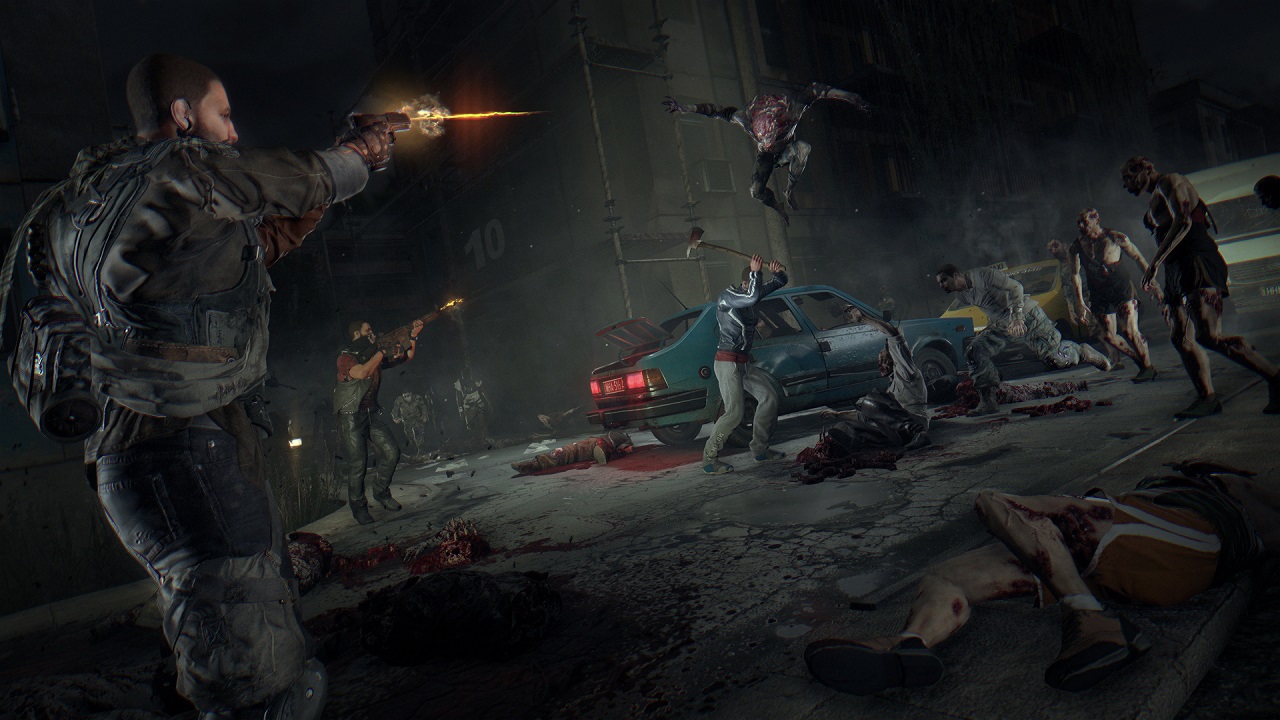
The largest disappointment however come from the way the story comes to a conclusion. Without delving into the realm of spoilers, the game concludes on a mission that feels like it is supposed to be momentous and yet ends up feeling very disconnected from the rest of the storyline save for another plot MacGuffin. Several of the events on that mission make almost no narrative sense and, worst of all, it ends the game on a cliffhanger that, almost literally, screams for a sequel in order to conclude the overall plot, something that is becoming one of the worst sins a developer could make when crafting a story.
Dying Light definitely has problems when it comes to its story and will require a lot of work in order for a second entry to be worth caring about from a narrative perspective. Don’t play Dying Light for the story as there isn’t anything exciting to find here.
Into Darkness
Techland’s latest title definitely does not feel like much of a successor when compared to Dead Island from a storytelling perspective but what it lacks in narrative delivery, it makes up for quite strongly in its gameplay systems. At its core, Dying Light is very much just more Dead Island: you’re going around a large environment exploring, gathering and crafting items and, of course, committing genocide against the undead menace. The comparisons begin to fade thereafter though as Techland has implemented a number of significant new systems as well as improvements to the formula.
The biggest and most welcome improvement over the classic formula is easily the new parkour movement system. A simplified version of the work DICE put into Mirror’s Edge, free running in Dying Light will be your most frequent activity as it is very often the best tool you have on hand to stave off death at the hands of the infected. Parkour movement is quite easy to do once you get used to the control scheme and thanks to a simple look-then-leap mechanic, you’ll find yourself navigating the environment very quickly in no time at all.
Parkour movement is augmented further in Dying Light once you have unlocked the game’s grappling hook. Similar in use to games like Zelda and Just Cause, the grappling hook allows you to, quite literally, climb most of the buildings in the game in a single bound with just the press of a button. The grappling hook also sees use when attempting to descend, allowing you to save yourself from a potential fatal fall so long as you haven’t yet hit terminal velocity. Despite its cool down and the fact that it isn’t very useful against enemies (I had high hopes I could play as Scorpion from Mortal Kombat), the grappling hook is an immensely fun tool the player will quickly come to love.
Combat in Dying Light follows the standard formula for melee-focused FPS titles these days like Skyrim and Condemned in which you have the standard amount set of light, heavy and special attacks whose effectiveness is measured primarily by the strength of the weapon being wielded. Players are given a stamina bar that diminishes after each attempted strike and replenishes when the player does not attack after several seconds. Zombies can take advantage of that brief moment and come in for a quick bite in which players have to mash a button to free themselves. In this regard, the game will no doubt remind some players of the stamina system present in From Software’s Souls series so if you are familiar with them then you should feel right at home.
Despite the strong, albeit repetitive, melee combat to be found in Dying Light, the combat does suffer in one distinct department: gunplay. It wouldn’t be a zombie game if Techland’s latest didn’t include firearms to use against both the living and the dead but, like Dead Island before it, combat with these weapons is rather terrible. The three pistols, two rifles and singular shotgun in the game may be very powerful but they are all terribly clunky to wield and cannot be augmented using the crafting system. Several missions in the game all but require using a gun against enemies but thanks to the hampered mechanics it ends up making these firefights feel very tedious and uninteresting. I found myself only using firearms against human opponents or when absolutely necessary. This is a big problem that Techland needs to address in the future.
Enemy variety is a mixed bag as well. Just like Dead Island, Dying Light chooses to provide you a variety of zombie types to deal with that are gradually introduced as you progress through the game. And, also like its predecessor, it harps on the same types of infected to deal with that we’ve seen in games like Left 4 Dead. You’ll encounter your typical walkers, your runners, projectile-based spitters that can poison you, ones that will explode, big brutes and more. If you’ve played Techland’s previous effort or Turtlerock’s work you pretty much know what to expect. There are a few exceptions to this rule though. Volatiles, monstrously vicious infected that only come out at night, are your biggest dread for the first six or so hours of the game and are rather well done. Another type does not engage you at all, choosing instead to flee from the player which provides an interesting change of pace but outside of one particular quest line, it serves little purpose. One particular zombie that is introduced late into the game which I won’t spoil will no doubt make you remark on how surprising it is that Techland went that extra mile this time around so kudos to them in that regard.
Dead Island back in 2011 was one of the busiest games of that year thanks to not only the length of the core storyline but also the amount of side content to do. Dying Light repeats this trend by offering several dozen side quests, sets of collectibles and sub-objectives to complete. The most exciting of these comes in the form of air drops, sequences that take place randomly throughout the first half of the game in which cargo planes will fly overhead and drop off crates full of valuable supplies to the survivors. Landing zones are marked by red smoke and, if the player is fast enough, they can get to the site and retrieve the contents unopposed. Less speedy players though may have to contend with bandits, curious zombies or both. It’s very exciting as your controller beings to shake and you hear the distant roar of the plane and they will become the most entertaining deviation from the main plot.
Player progression is built upon a set of three skill trees focusing on the actions you take in the game: survivor, agility and power. Each one levels up separately from one another and is not pooled collectively, nor do they share the earned skill points. Thus, players that focus on parkour and athleticism will earn agility points while those that focus on combat and zombie killing will earn power points respectively. Every action you take, from hitting a zombie to climbing a ledge, earns you points and the game constantly reminds you of that thanks to numbers that appear on screen and slowly fill the XP bars for each skillset that is constantly on the top of your HUD. The Survivor skill tree, the exception to these rules, is earned through quest completion and, unlike the other two, is subject to player fail conditions but more on that in a minute. Based on your playstyle it is quite easy to find yourself quickly leveling up one tree over the other which can be potentially hazardous. Dying Light would have definitely benefited from a shared skill point pool rather than forcing the players to focus on one ability set over the other to become a stronger, faster character but this is a nitpick that many will more than likely not mind.
Within each skill tree you will find an assortment of exciting and exceptionally useful abilities to unlock that make taking risks a more tantalizing prospect. The previously mentioned grappling hook, for example, unlocks halfway through the survivor tree while the laugh-inducing dropkick appears under agility. Naturally, some of the more interesting and useful abilities are unlocked much later in the trees than one would wish for and the more potent ones require unlocking other skills before you can earn the ones you desire. Again, this is where a pool of skill points would allow a player build interesting characters but the game simply doesn’t allow that.
One of the most prominent features Techland chose to include in Dying Light is the much publicized day/night cycle. Players will spend roughly fifty minutes of each hour in daylight completing whatever they please. However, as the day winds down and the sun begins to set, the player begins to receive radio warnings that heed survivors into safe zones. As your watch beeps to warn you of the impending nightfall and you begin to hear inhuman howls in the distance, we are granted access to the nighttime sequence and it is here in which the game changes tone entirely from a zombie killing playground to that of stealth based horror.
Nighttime sequences are an accelerated period of time lasting only ten minutes a piece but for that brief span of time, the game forces you to completely change your in-game discretion regarding combat and exposure. In the night appear Volatiles, a zombie type that are both exceptionally vicious and fast in hunting down and chasing the player in the dark. Your minimap shows their cone of vision ala classic Metal Gear Solid and if you are caught in their gaze for too long, the pursuit begins. At this point, only more leveled up players have the realistic option of engaging the attackers as lower level characters don’t have access to the tools necessary to make staying out at night anything but a hard prospect.
To prevent the player from simply retreating to a safe zone and resting until daylight, Dying Light includes a few measures that make staying out at night more enticing. Beyond just the inclusion of high reward quests that take place only at night, the nighttime sequences double the amount of agility and power XP that you earn. Smart players can quickly level up during this short period by simply forcing a chase to occur and escaping successfully, which yields a massive dump of points to both skill trees. Though this is not encouraged early on in the game, mid-level players will benefit tremendously if they are able to survive the night.
Chase sequences can be a bit tricky to play through though thanks to how traps work. Throughout the game, you can unlock a series of traps and tools to aid in dealing with the infected through the game’s agility skill tree for which some of them are specifically designed to aid the player when being chased. From ultraviolet flares and lamp posts to exploding cars electric floors, there are plenty of tools at your disposal in the event that you need to flee, especially at night. While they can be useful, the way the game informs the player of traps they can utilize is extremely limited in scope, all but forcing you to memorize their locations as they don’t appear on the HUD unless you are within a certain distance of them and, even then, only on your minimap. Assassin’s Creed, by contrast, maintains the trap icon on your minimap at a much greater distance and these trap locations take place that feel natural in location for the direction in which you are fleeing. Dying Light, however, doesn’t afford the player this luxury. In addition, the point of traps are significantly downsized once you get to the second area of the game as you’ll find most of your time being spent bounding off rooftops instead of on the streets below. This is definitely an area Techland needs to take a look at in the future.
Sadly, it is the day/night cycle wherein I find one of the biggest missed opportunities for Dying Light: time management. Throughout the course of the game, the player is constantly given deadlines, timespans and reminders of the importance and necessity of their actions. From radio calls warning of the impending destruction of Harran in just a few days’ time to retrieving flesh from a special zombie type at night for study that needs to arrive in less than a few hours, the game seems determined to press you on your progress. Despite this, the game makes no effort to actually make you proceed in as timely a manner as possible. There are no actual time limits in the game at all! At one point I clearly remember being told that I must complete a mission post haste and only after nearly a week had passed did I finally get around to accomplishing the goal. This is, of course, to say nothing of Antizin being a story gimmick to move the plot along and not also a gameplay opportunity. Allowing players the freedom to do whatever they want, whenever that want is fine in a lot of open world games but in one such as this, stressing the player with time management can actually make for a better game. In my opinion, Dying Light would greatly benefit from an update that includes such a mode.
Fail conditions for Dying Light are curiously worked into the experience. Death, of course, is never the end in a video game but the measures by which the player is punished for such an occurrence encourages the player to engage in a playstyle you wouldn’t expect: suicide runs. Like only a few games before it such as Red Faction Guerrilla, outside of a core store mission, death does not reset the state of the world, instead allowing it to continue on as if you didn’t actually die. Players will respawn nearby, back to full health, and can immediately return to whatever they were doing with all the conditions that existed beforehand still going on. Die at the hand of a few bandits but you managed to kill one or two? Returning to that spot will see that exact scenario still there. It’s a strange design choice to not punish the player like any other game and given that the only penalty the player incurs is the loss of survivor points towards their next skill level, it almost feels like cheating. Though I don’t want to advocate for strict penalties for players, the game would benefit from providing a greater incentive to stay alive as much as possible in the face of dying on purpose to make subsequent lives easier.
Payoff is also an issue I find fault with in Dying Light. Despite several dozen side quests to complete, none of them really have an effect on the delivery of the game’s narrative. Missions in which you are told will dramatically improve the lives of your survivor allies or greatly harm your enemies has no actual bearing on both the story and the gameplay. Side quests, instead, focus on XP rewards and new crafting blueprints for your weapons. One memorable quest forced you to climb to the one of the tallest points in Harran to retrieve some UV bulbs designed to deter Volatile zombies. With the promise of providing better protection from Volatiles around The Tower, you make the difficult climb, retrieve the bulbs, and rush back to the quest-giver at night. Your reward? XP and a blueprint with no world implications for your actions. Often times it just feels like your actions have almost no impact on the world around you and that should not be the case considering a lot of the side content you can accomplish.
Despite these flaws though, Dying Light remains a rather entertaining experience. The game is best played in co-op, of course, but the singleplayer is no slouch by comparison.
The Burning Remains
The second year of the console generation has begun and though we are certain to receive a number of cross-generation titles that are bound to hold back the potential of several games, Techland made the decision just a scant few months ago to make sure that Dying Light would not hampered by a last-gen release, shifting development of the game to PC, PS4 and Xbox One only. Has it helped though? Well, I cannot say for certain considering I don’t believe the game was ever demonstrated on the PS3 or 360 systems but I can suggested that the game can be rather stunning to look at.
Environmental design throughout the game is rather gorgeous and goes a long way toward selling a segmented, rapidly transitioning city. From the slums where you start out to an old colonial section of Harran, you get the sense this time around that this is more of a city than Dead Island’s ever could be. A dynamic weather system is included and really adds to the flavor of the areas you are in. Watching a storm sweep into the area as the clouds darken and the trees blow in the wind, it all looks great. The letdown however comes from the game’s variety of environments. At any high point in the game you can glace off into the distance where you will see a sprawling city filled with skyscrapers as well as tall mountains that would be great to visit. Sadly, those do not exist, as is the fate of many mentioned but viewable locations, the most egregious of which being the Harran stadium where the much-touted Global Games competition was supposed to take place and has been relegated to paid-for DLC. It’s not a bad effort for a first game but Harran would definitely stand for some more places to explore.
Though the public didn’t begin to take notice of Dead Island until after the infamous trailer for it was revealed, Techland first started talking about Dead Island long before any gameplay was revealed. Several years prior to release, the most publicized element of their eventual product was a real-time character deformation system that was just as gruesome looking as one could imagine. Sadly, Dead Island launched without this as it was very performance intensive. Dying Light, however, seems to have incorporated at least some of the deformation system. Combat with zombies will result in some gruesome violence, though it is limited to limb, pelvic and head damage. Still though enemies, before, during and after battle are disgustingly detailed in rather fantastic ways. From the exposed ribcages of a walker making his way toward you to the blood-drenched torso of the zombie you just cleaved in two, Dying Light features some of the most grisly violence to be seen this side of Mortal Kombat and it is glorious.
Audio design is well done… for the most part. Ambient environmental sounds are nicely done and do well to sell the area you are in. The game’s rather interesting soundtrack sticks to the idea of the game being a B horror film by including an entirely synth-focused score that feels ripped straight out of the 80s. The voice work does show some significant improvements over Dead Island and though character’s feelings come across decently, the emotional punch is hampered by the animation of the people on screen. Dying Light, it seems, reserved a lot of its mocap budget for only select cinematics and only in these do we get a feeling for our casts’ emotional canvas.
In short, Techland did a rather great job this time around from a production standpoint. There is, of course, room for improvement but this is a nice demonstration of the potential of the current generation of systems.
Dying By the Light
The latest game from developer Techland promises a lot of things. They want to tell you that this is a next generation zombie game filled with incredibly brutal combat, an exceptional parkour system and horrific, challenging enemies. Does Dying Light match those descriptions though? Well, mostly.
Dying Light is what Dead Island should have been: a well done open world zombie game with strong combat and a reason to be afraid of the dark. However, it’s riddled with questionable design choices and flaws that hamper the overall experience. If you can look past these inconsistencies and the game’s lacking story, you are in for a rather good time.